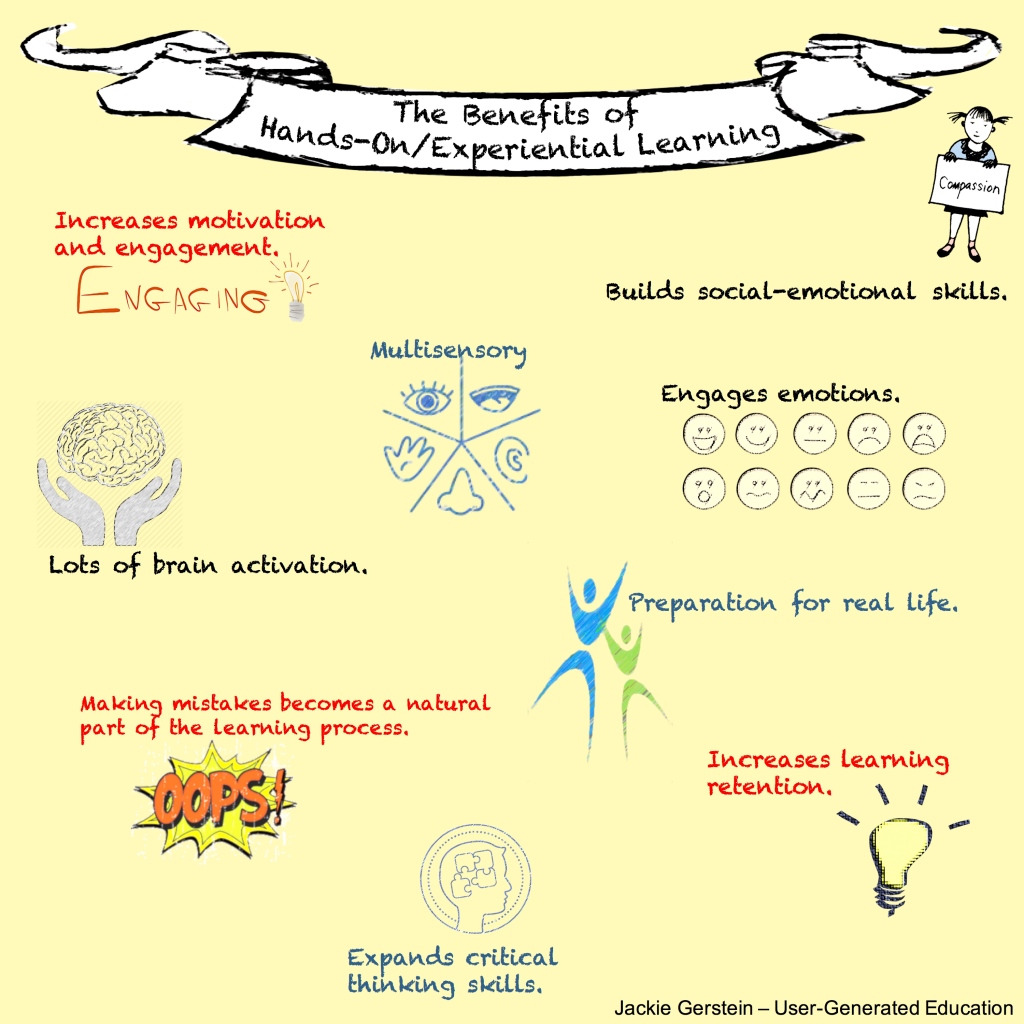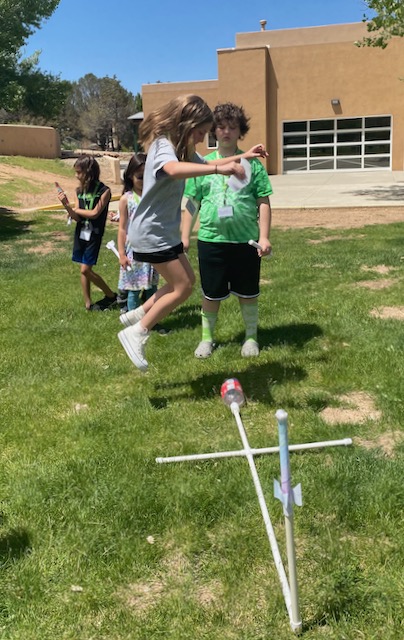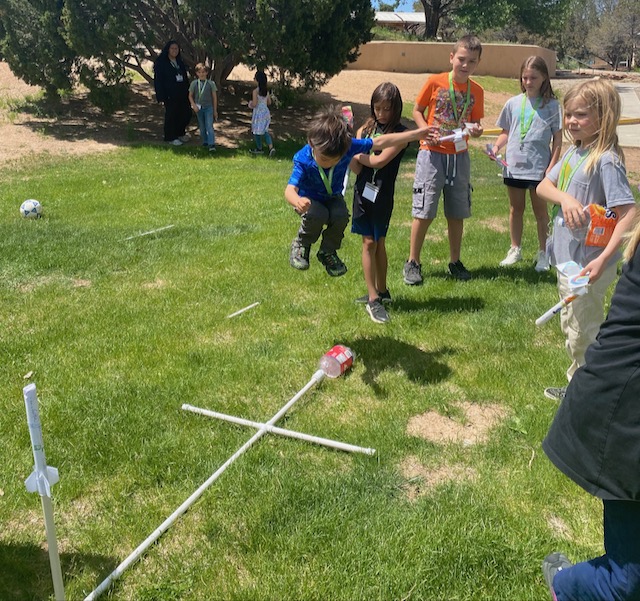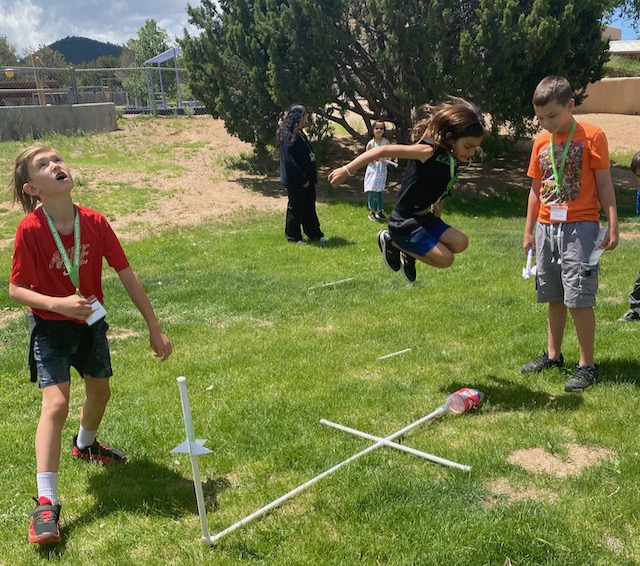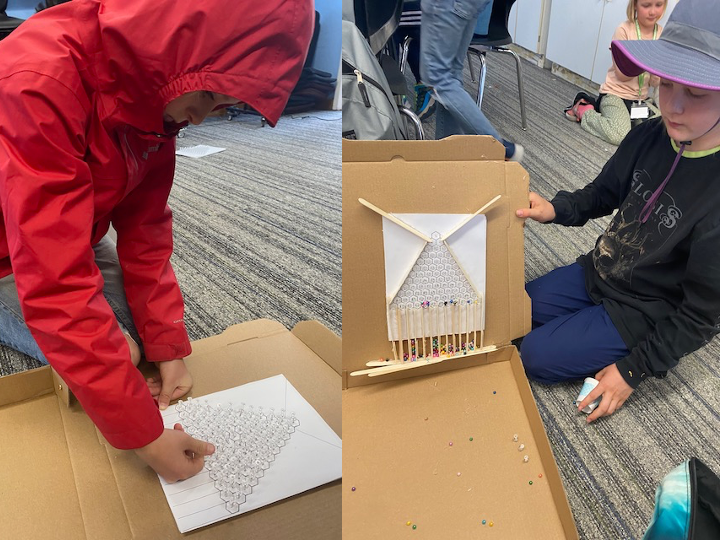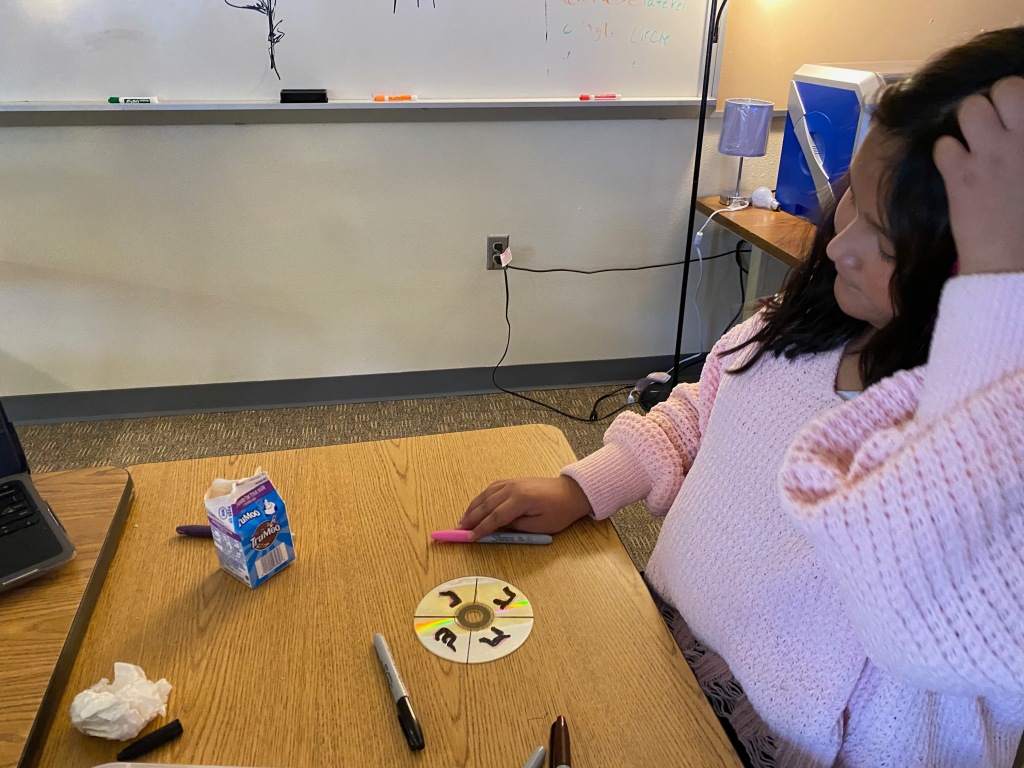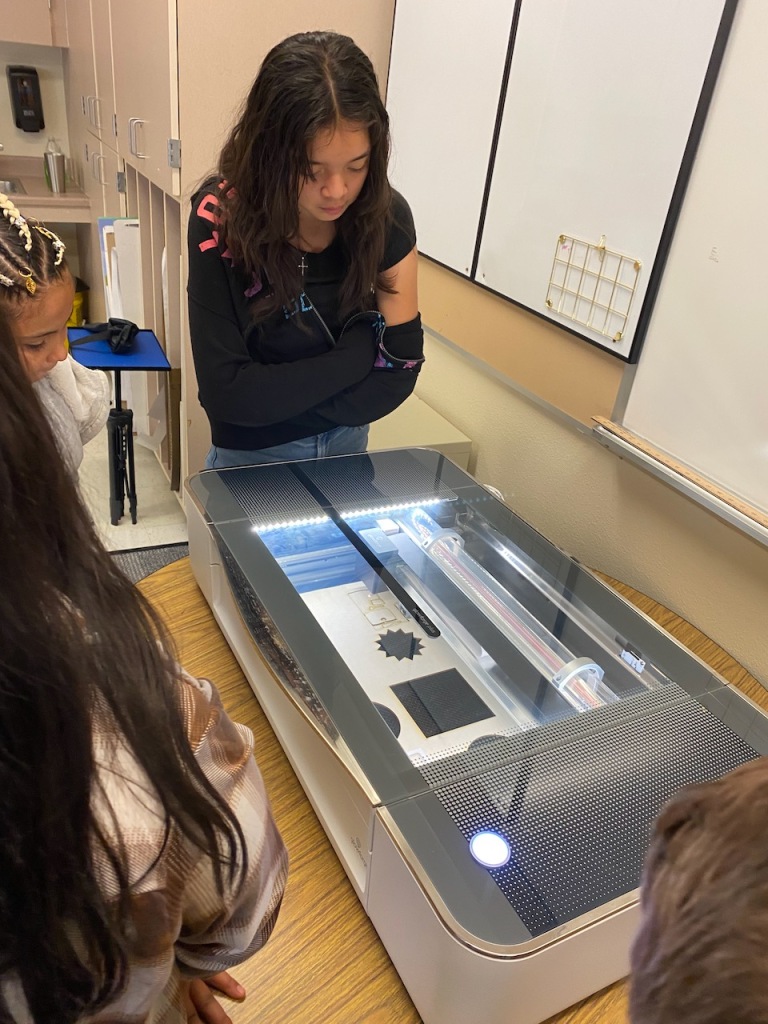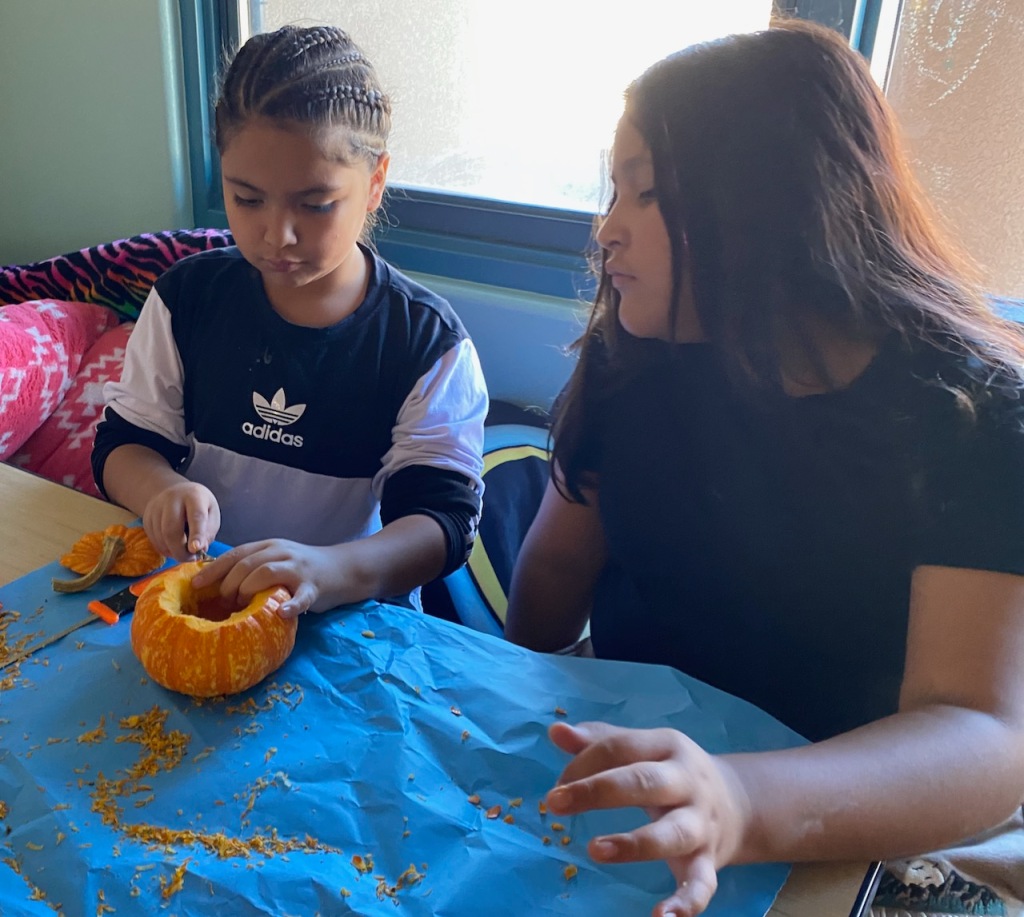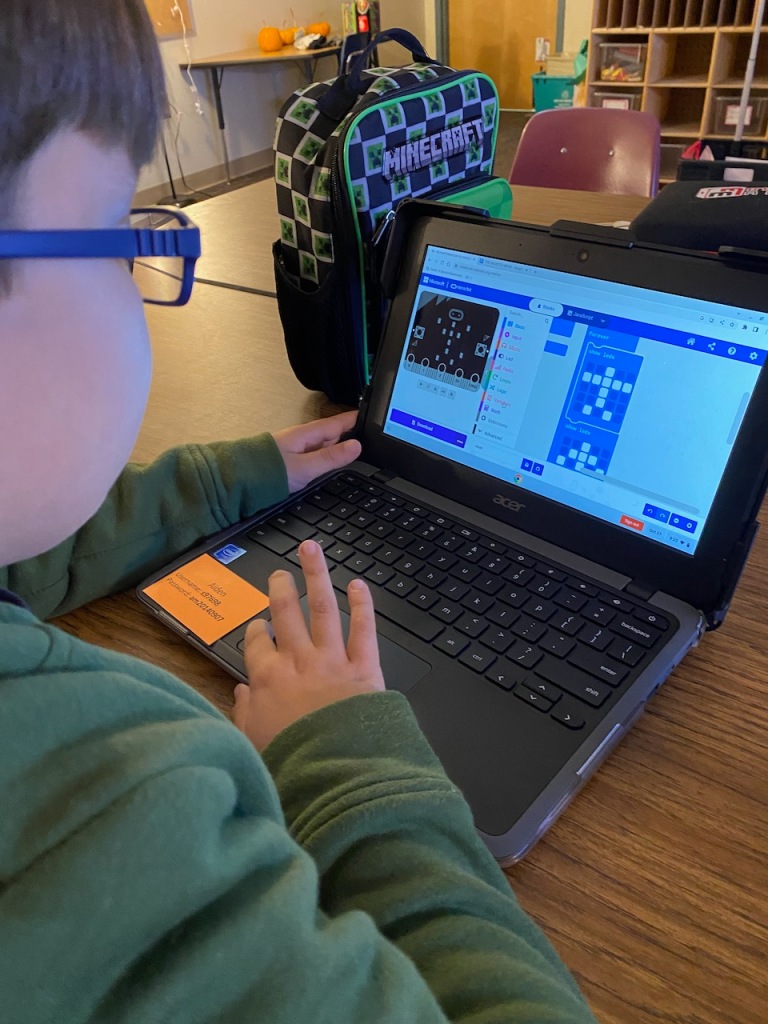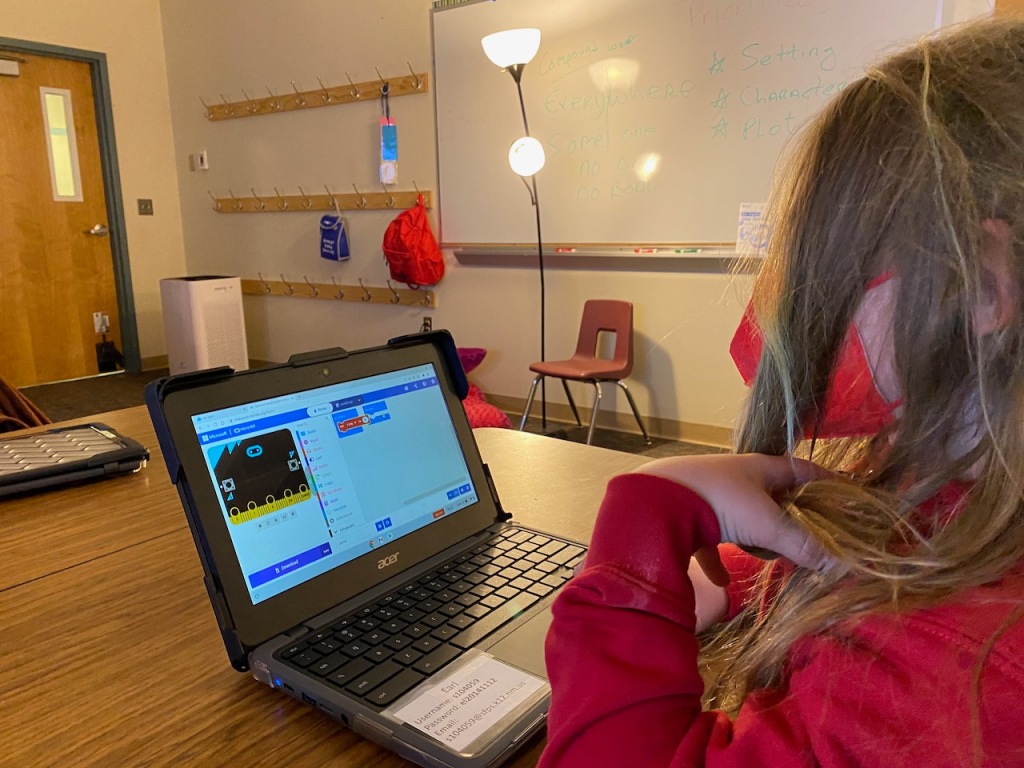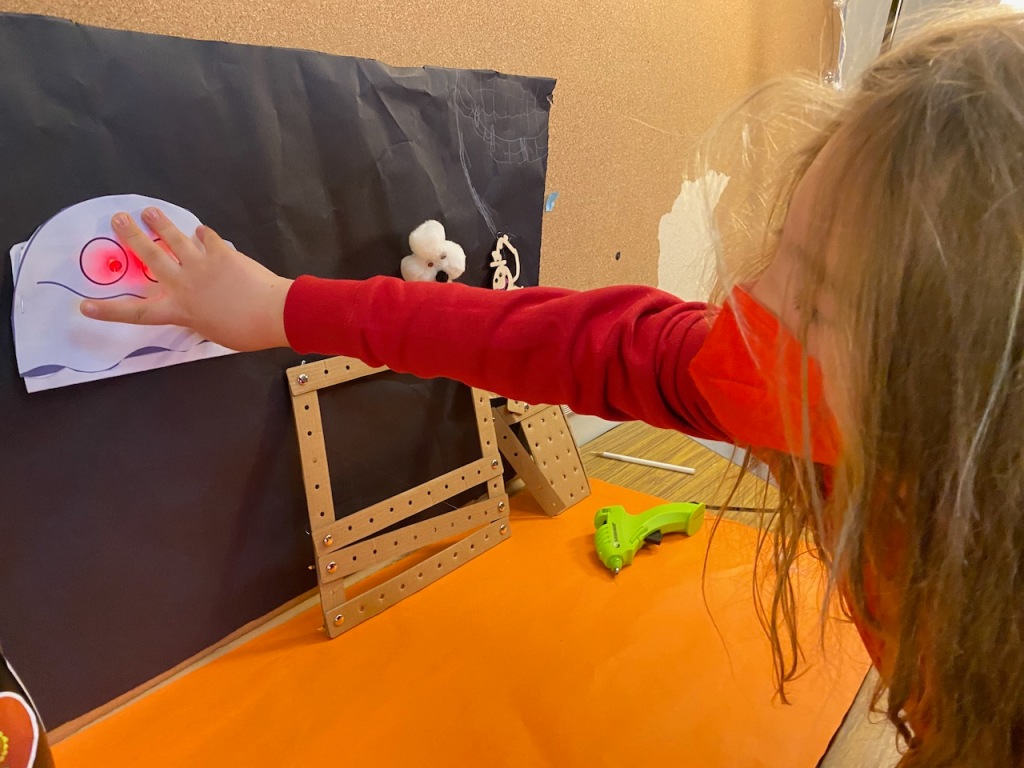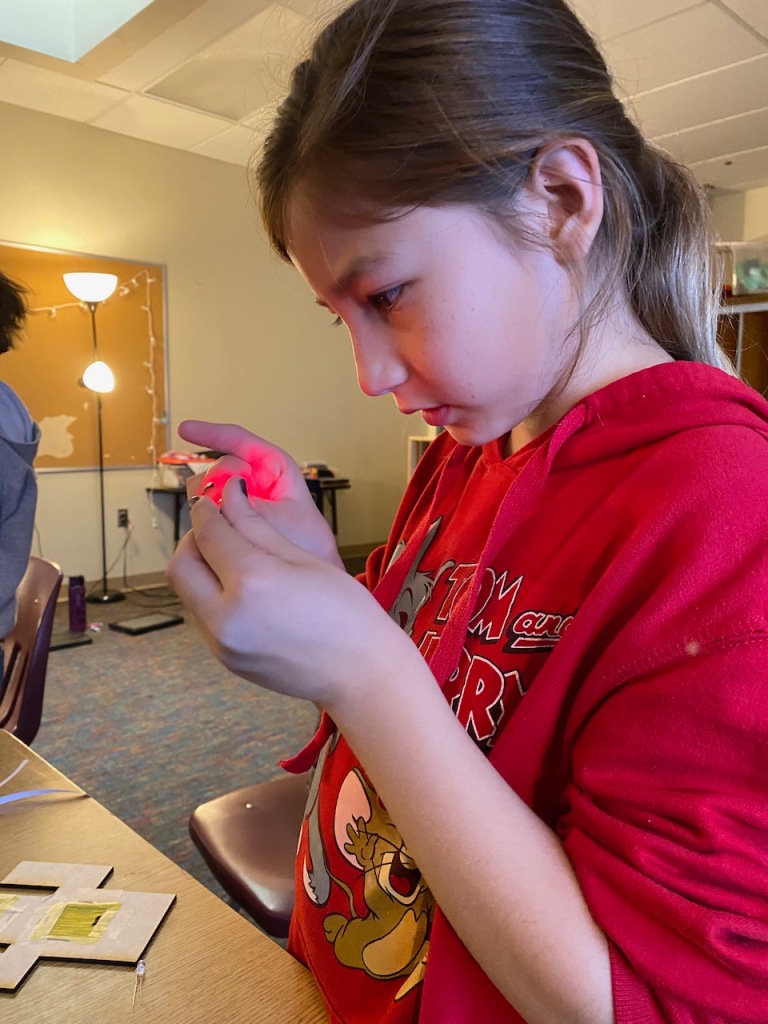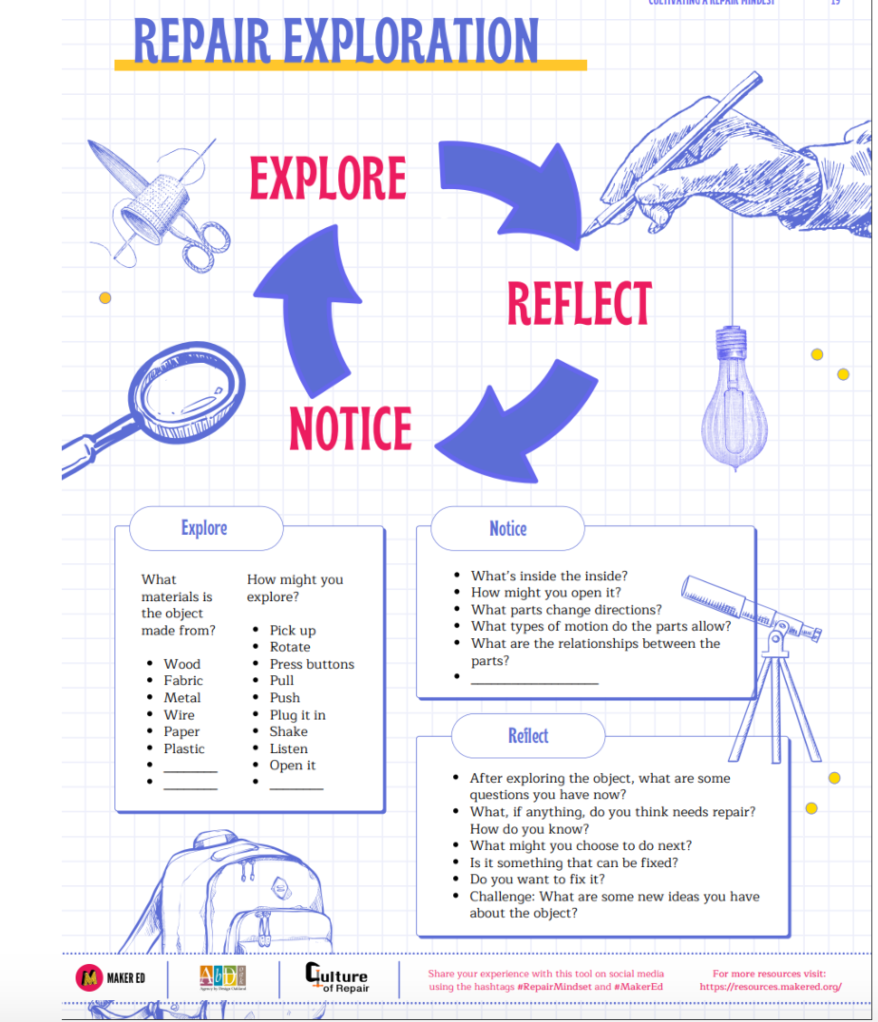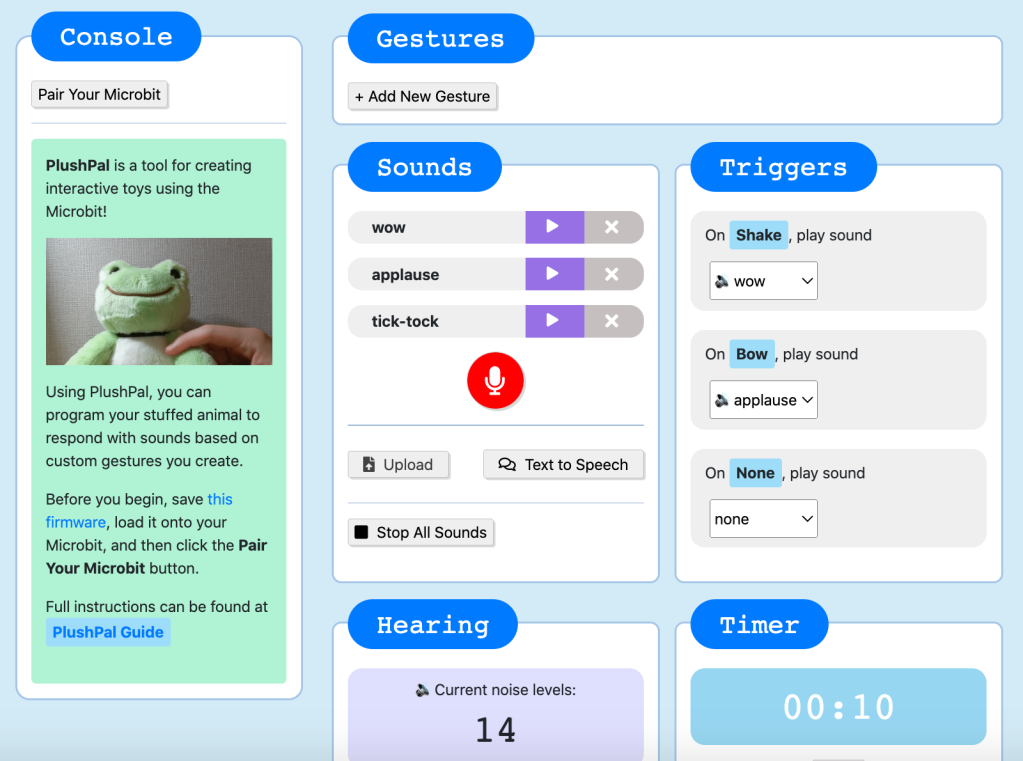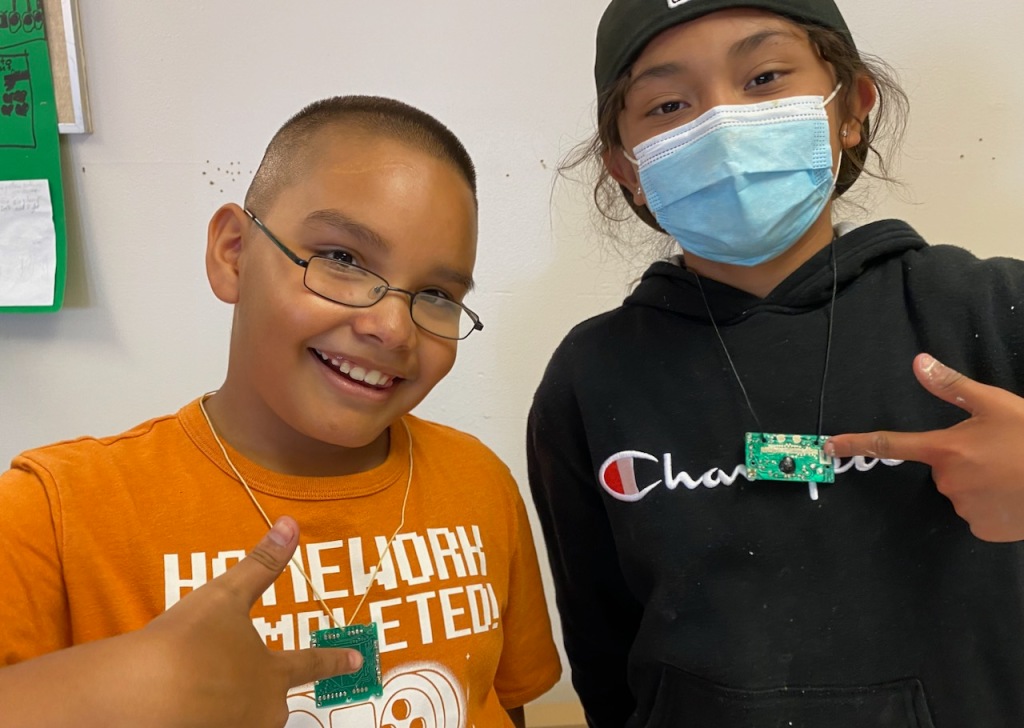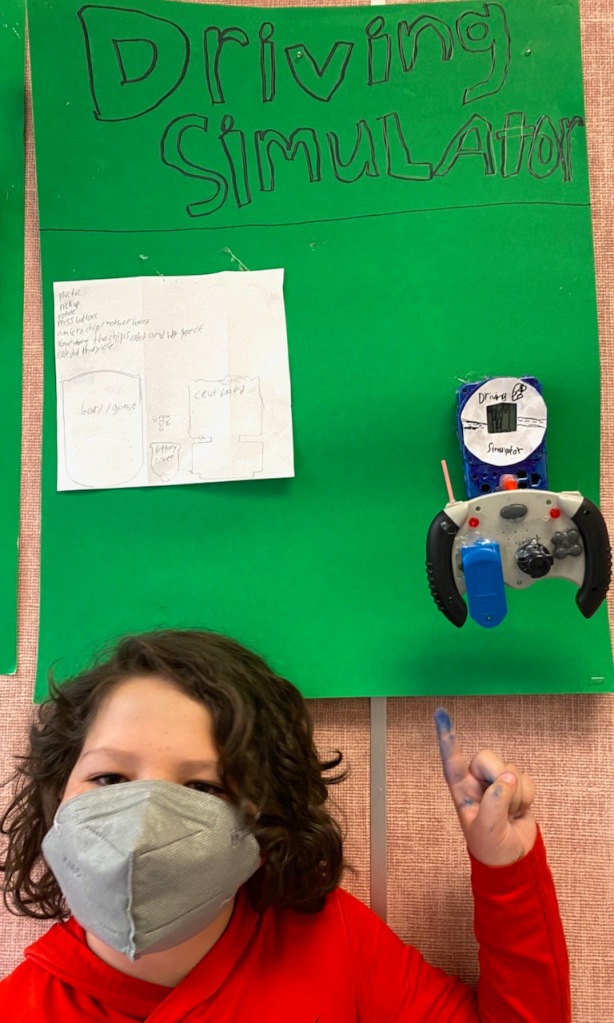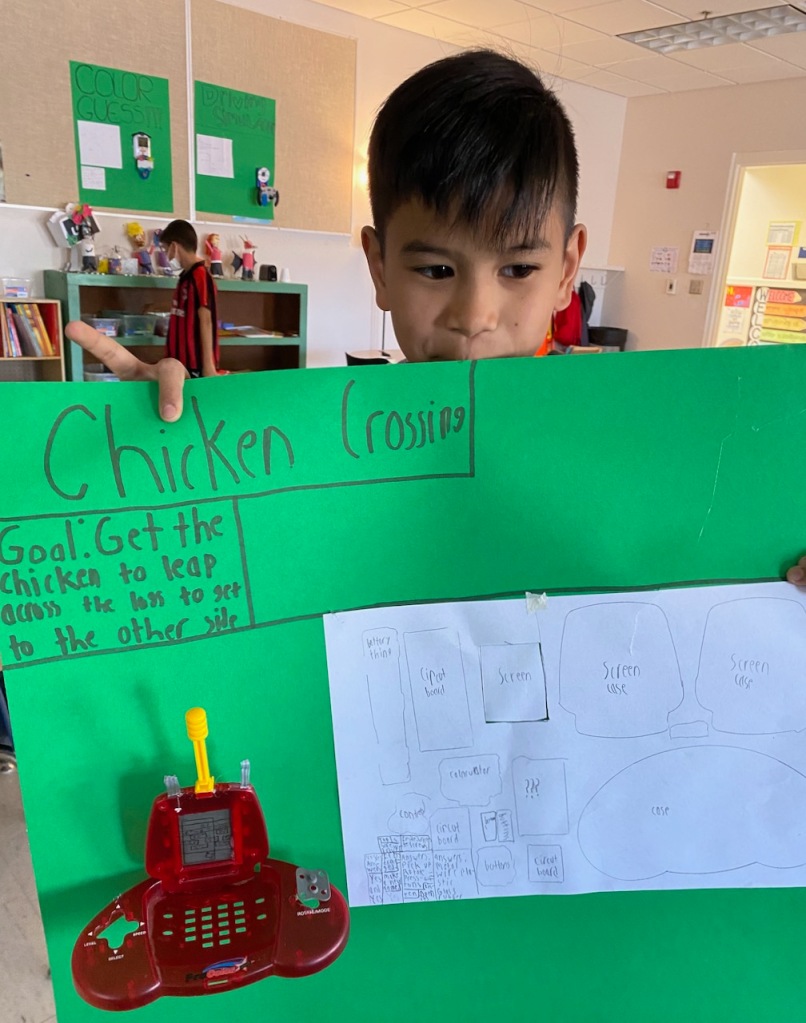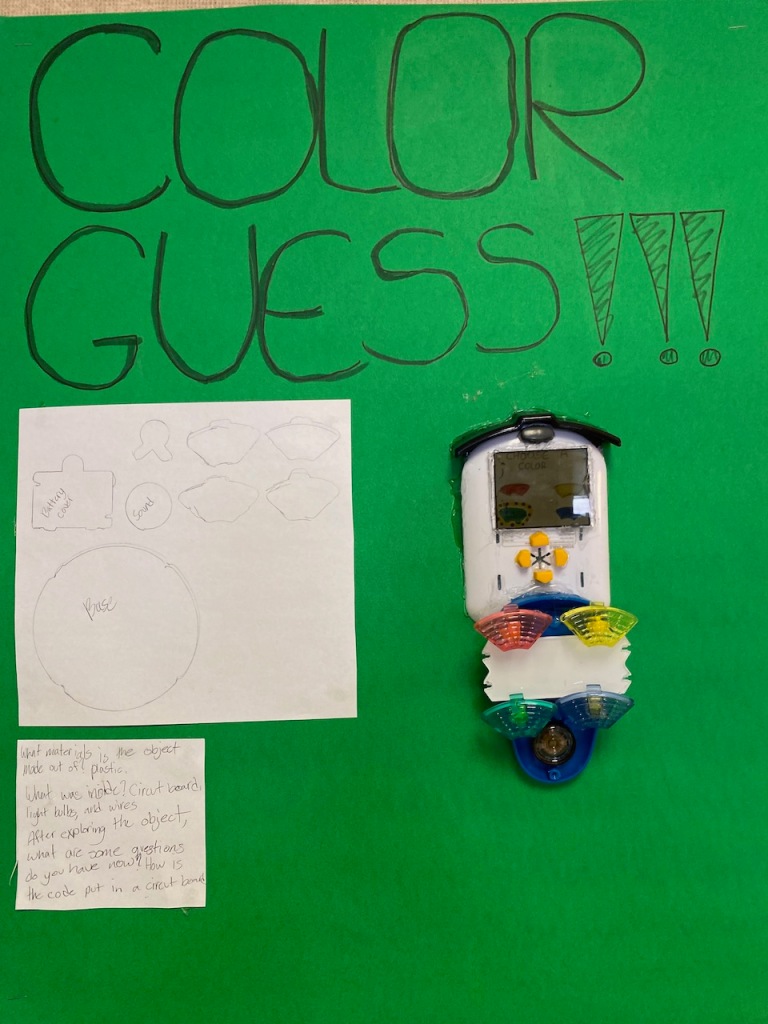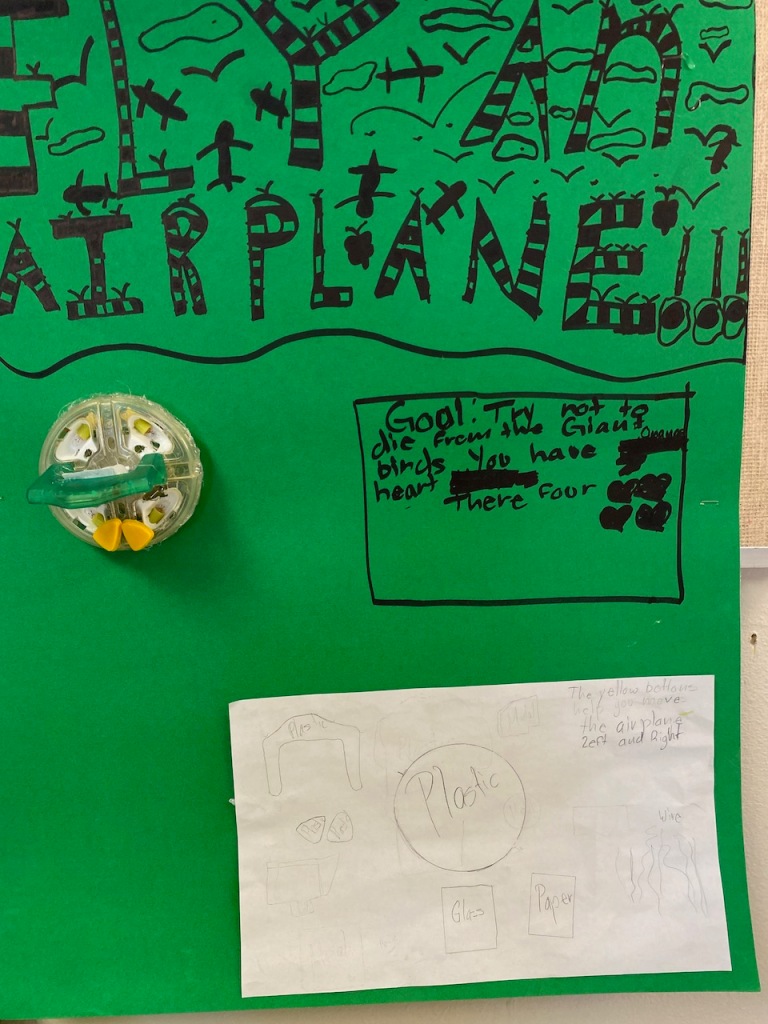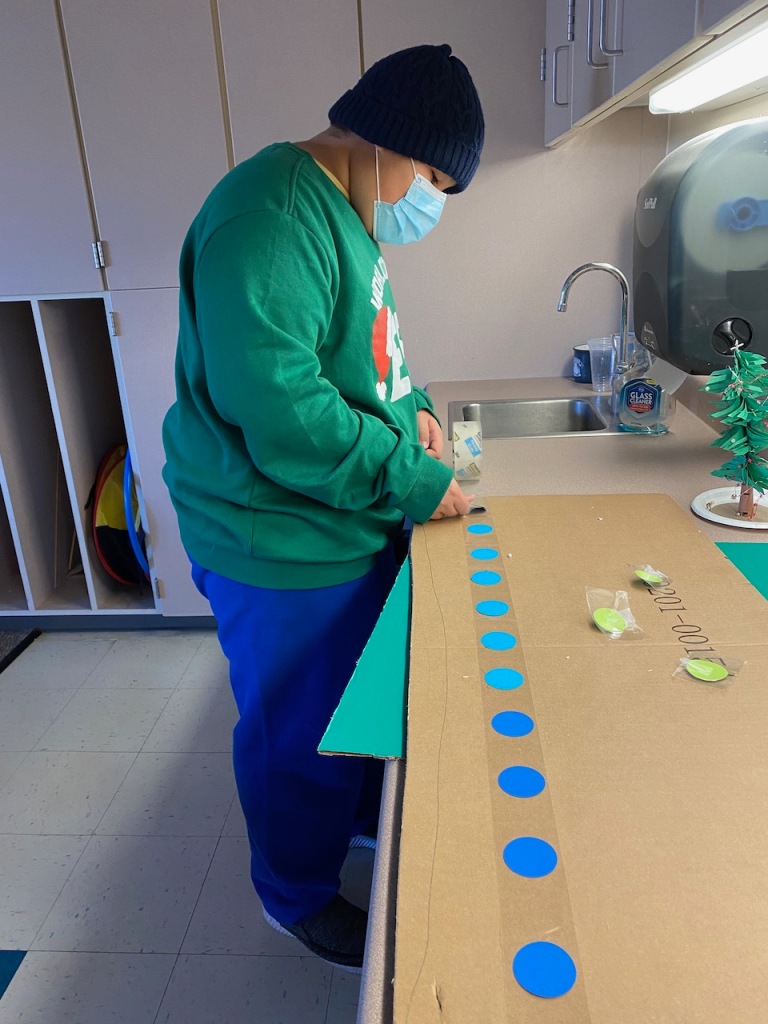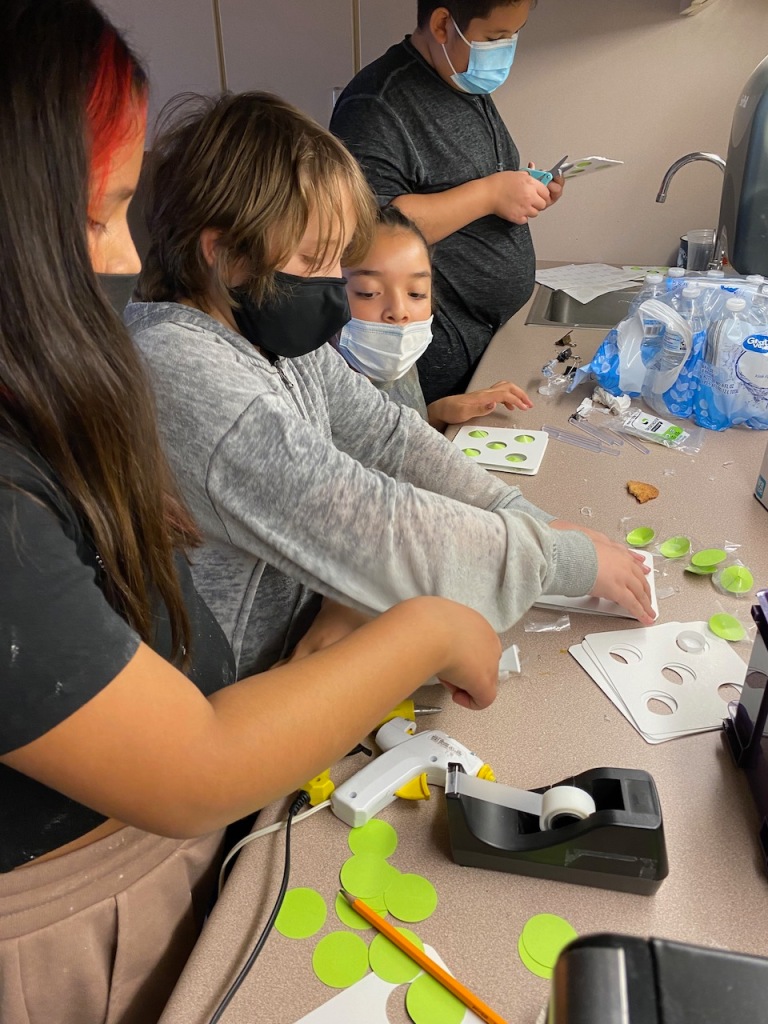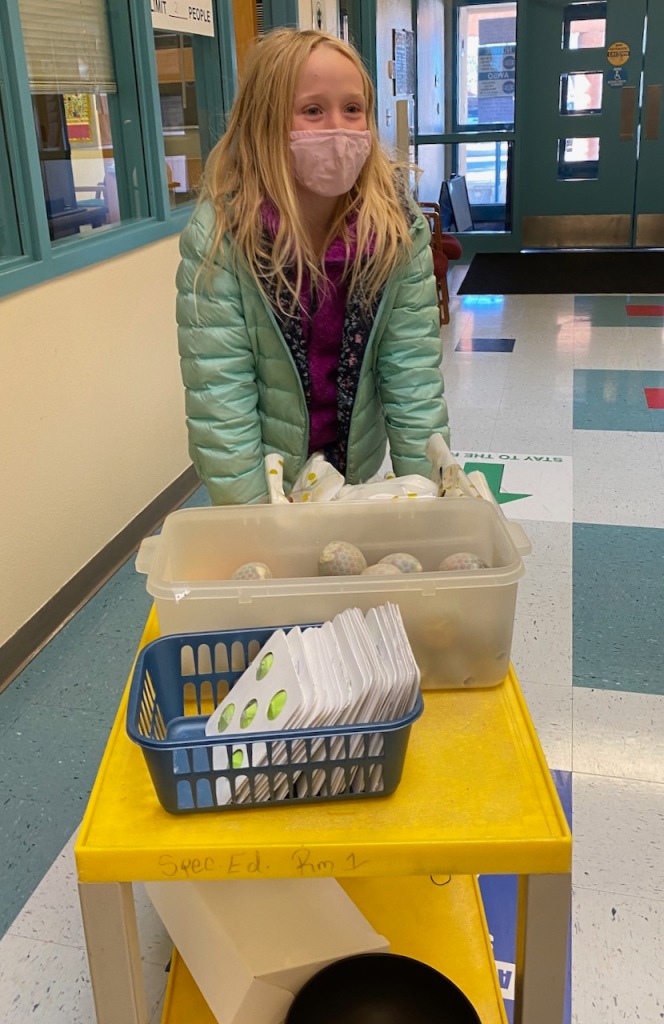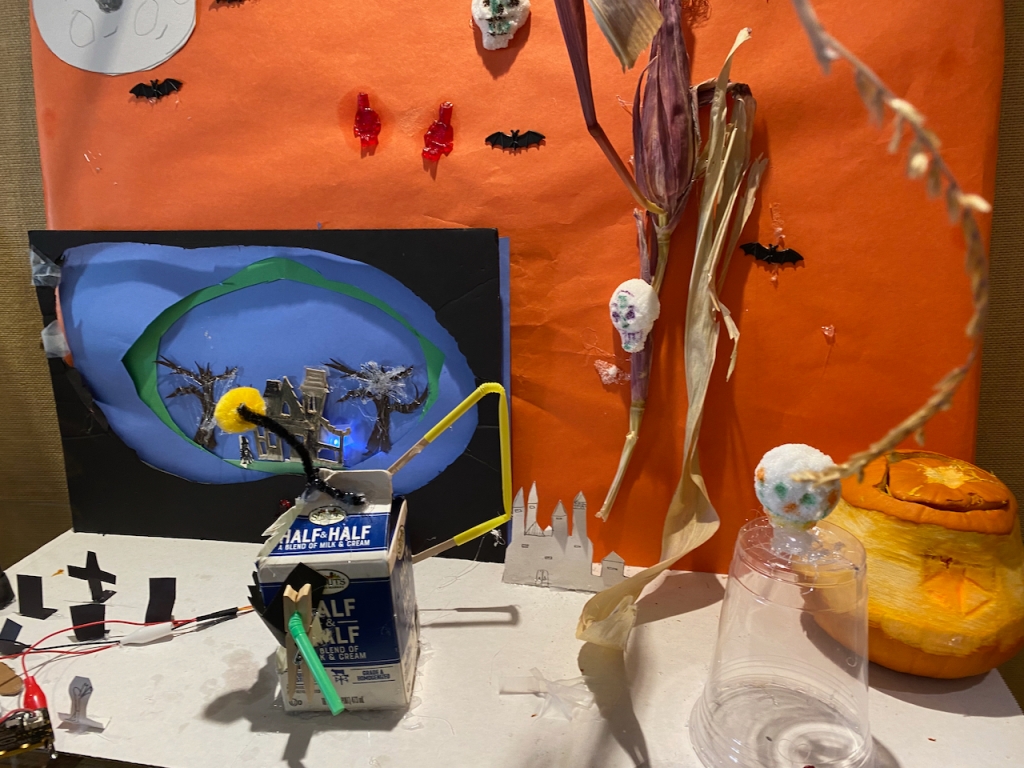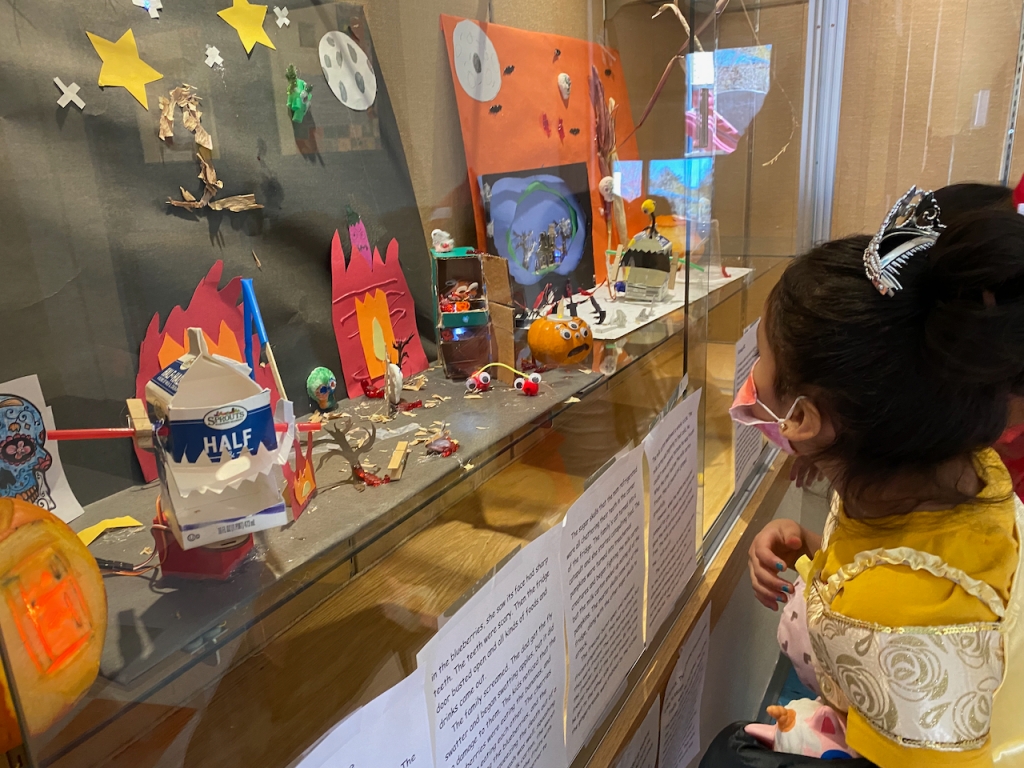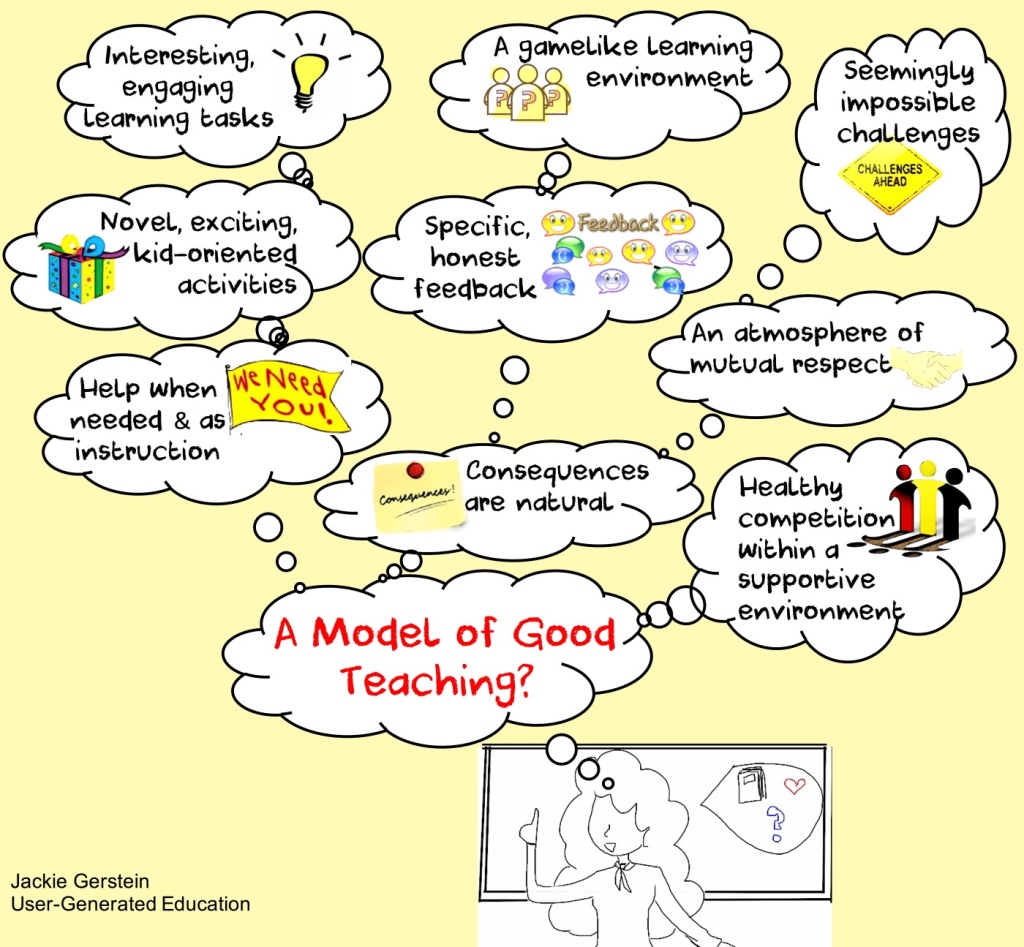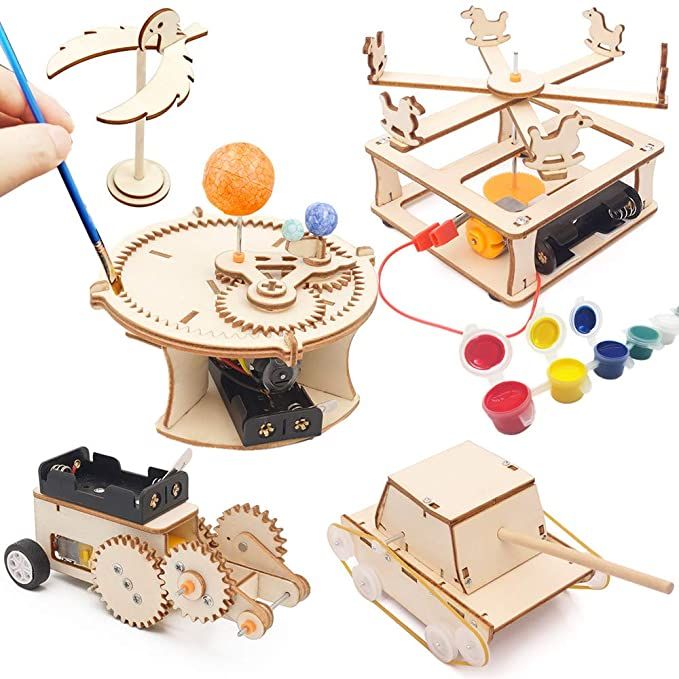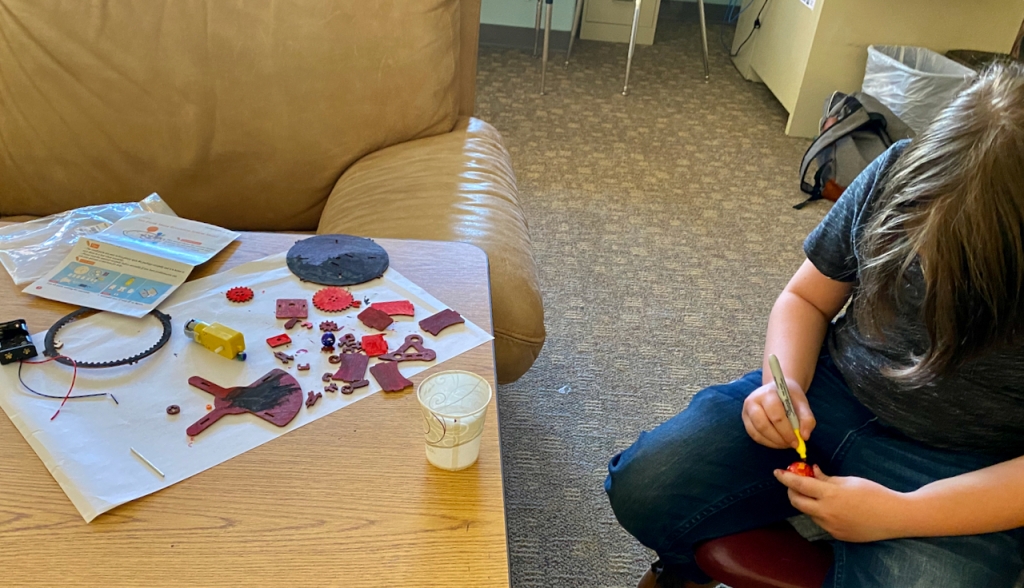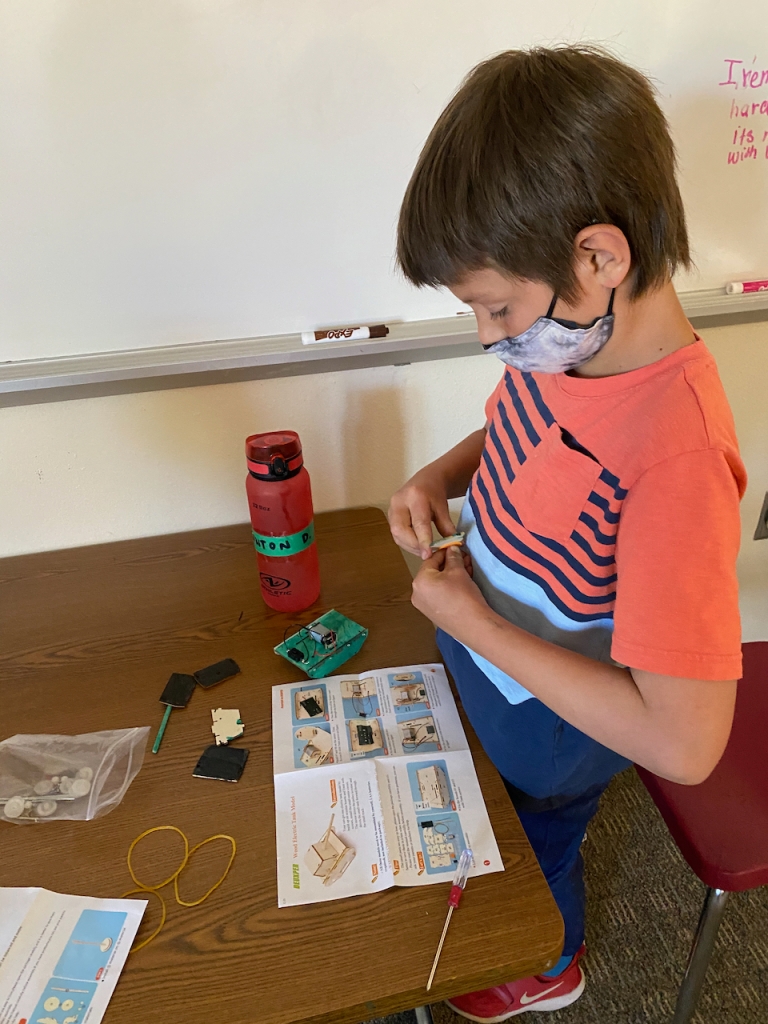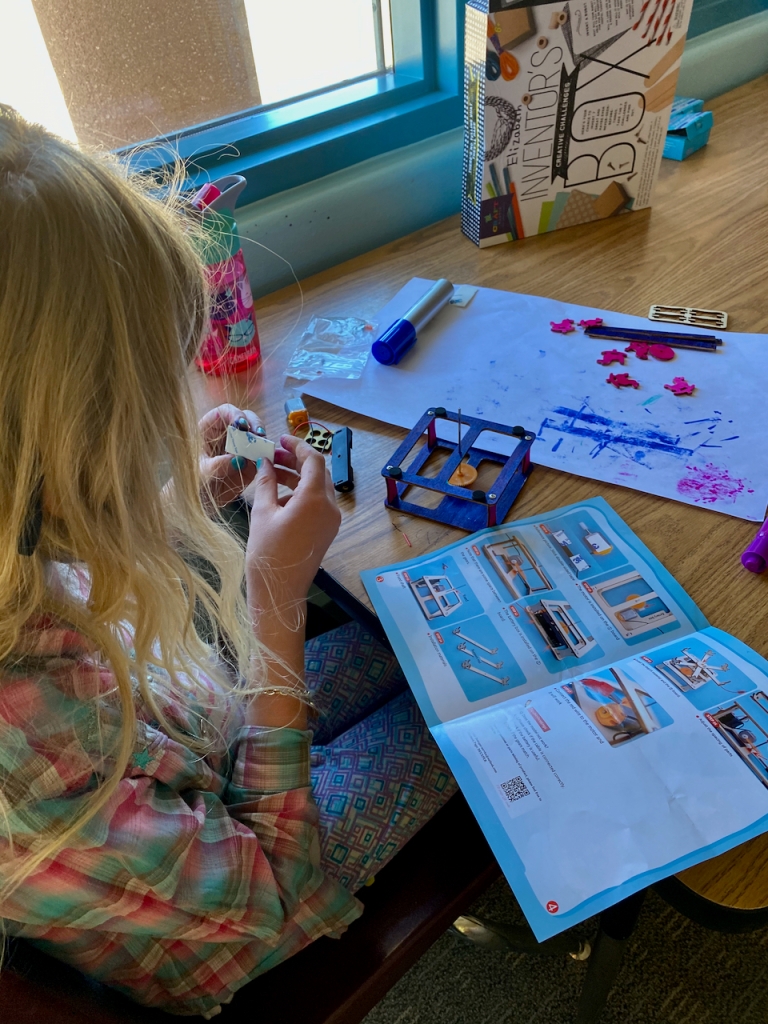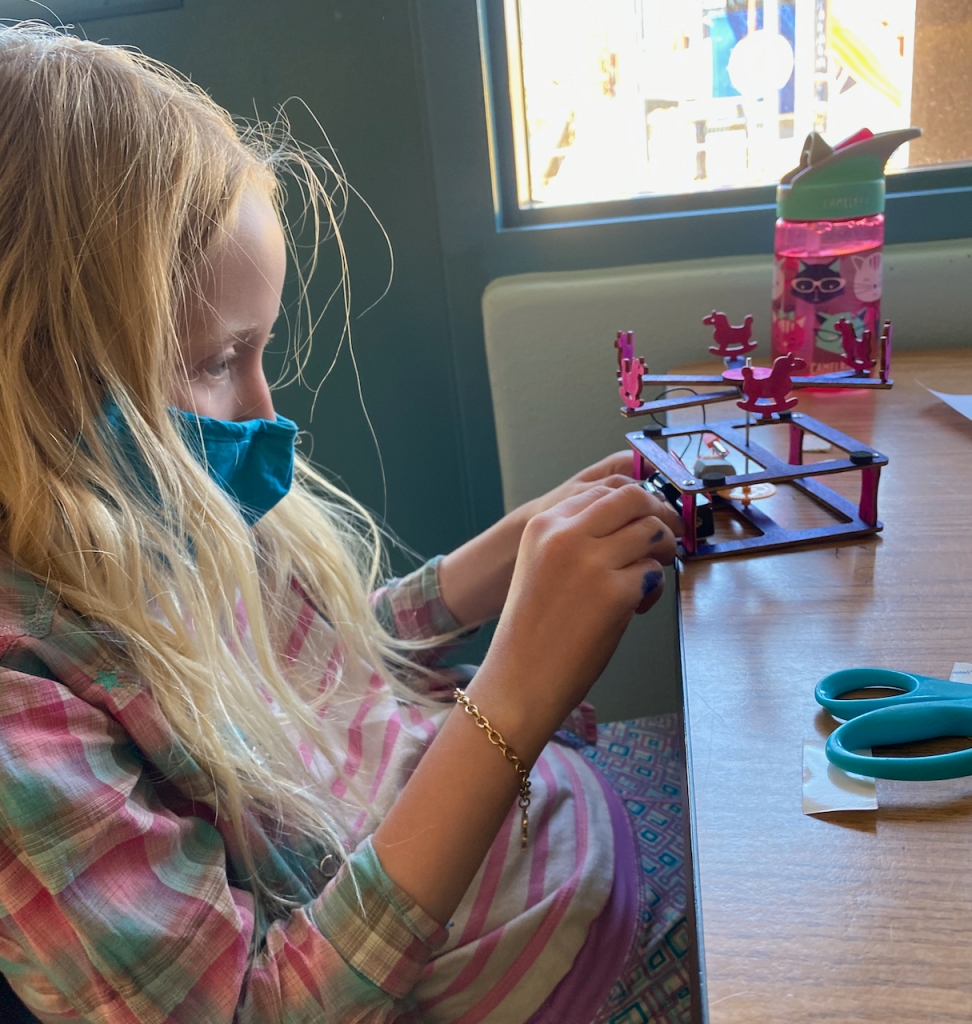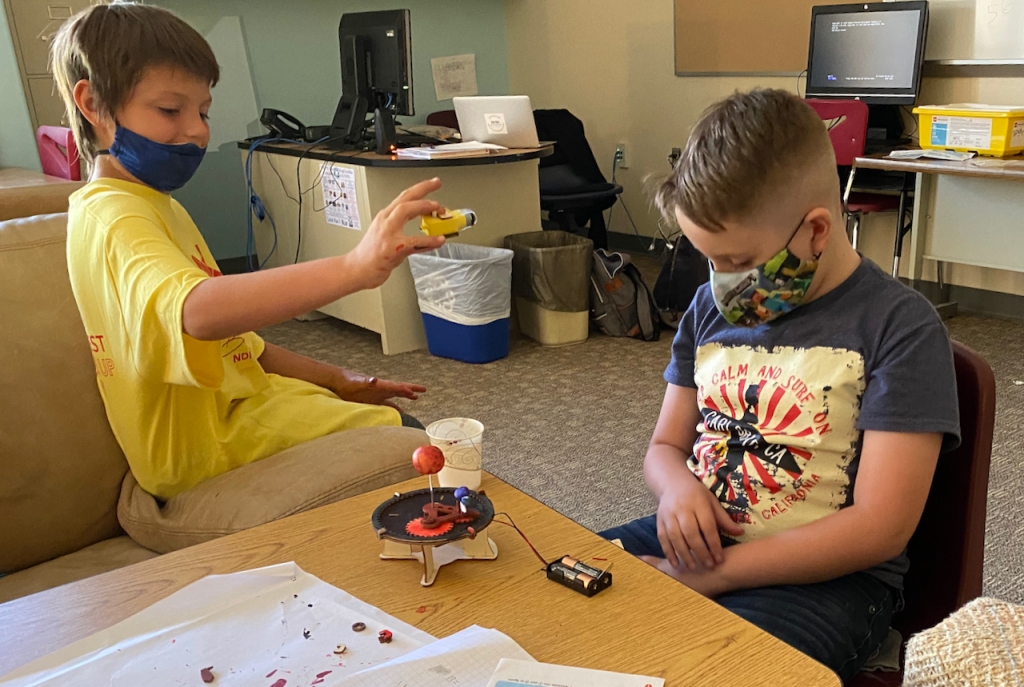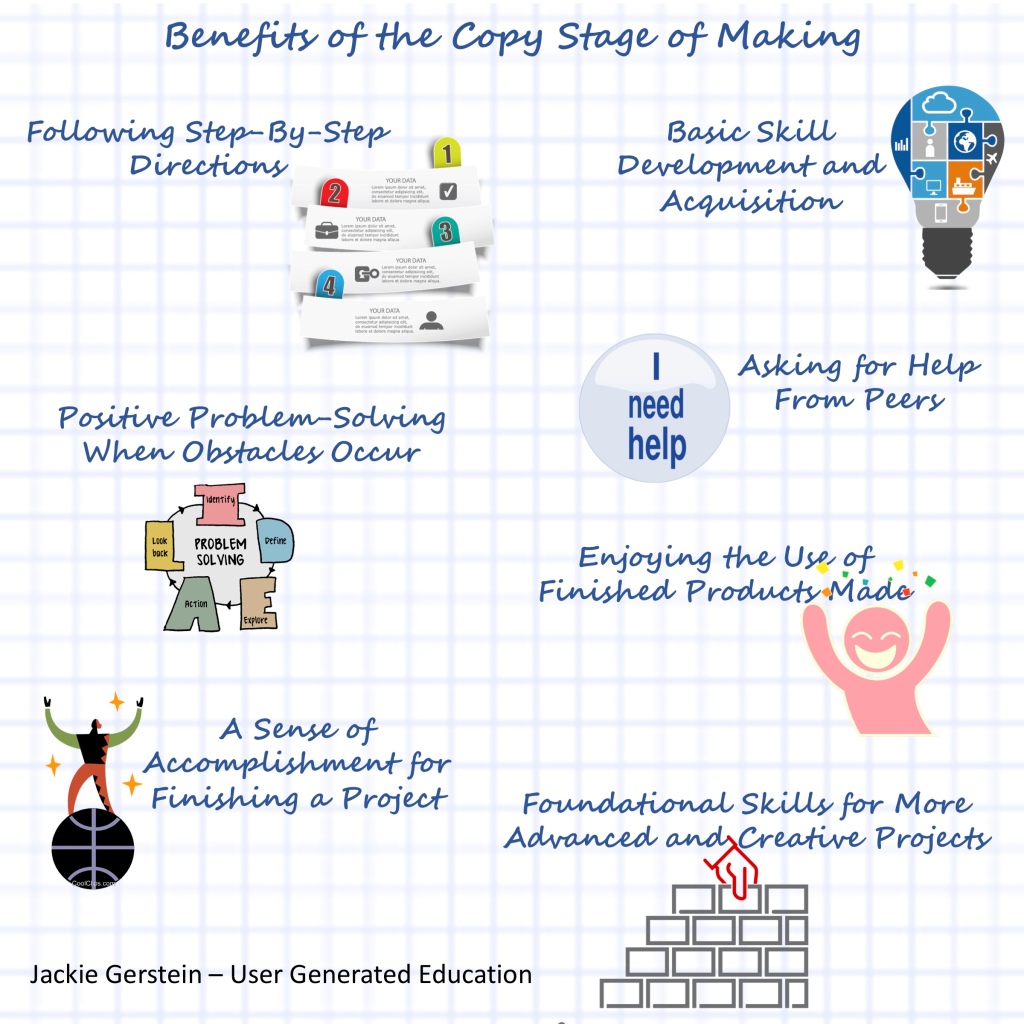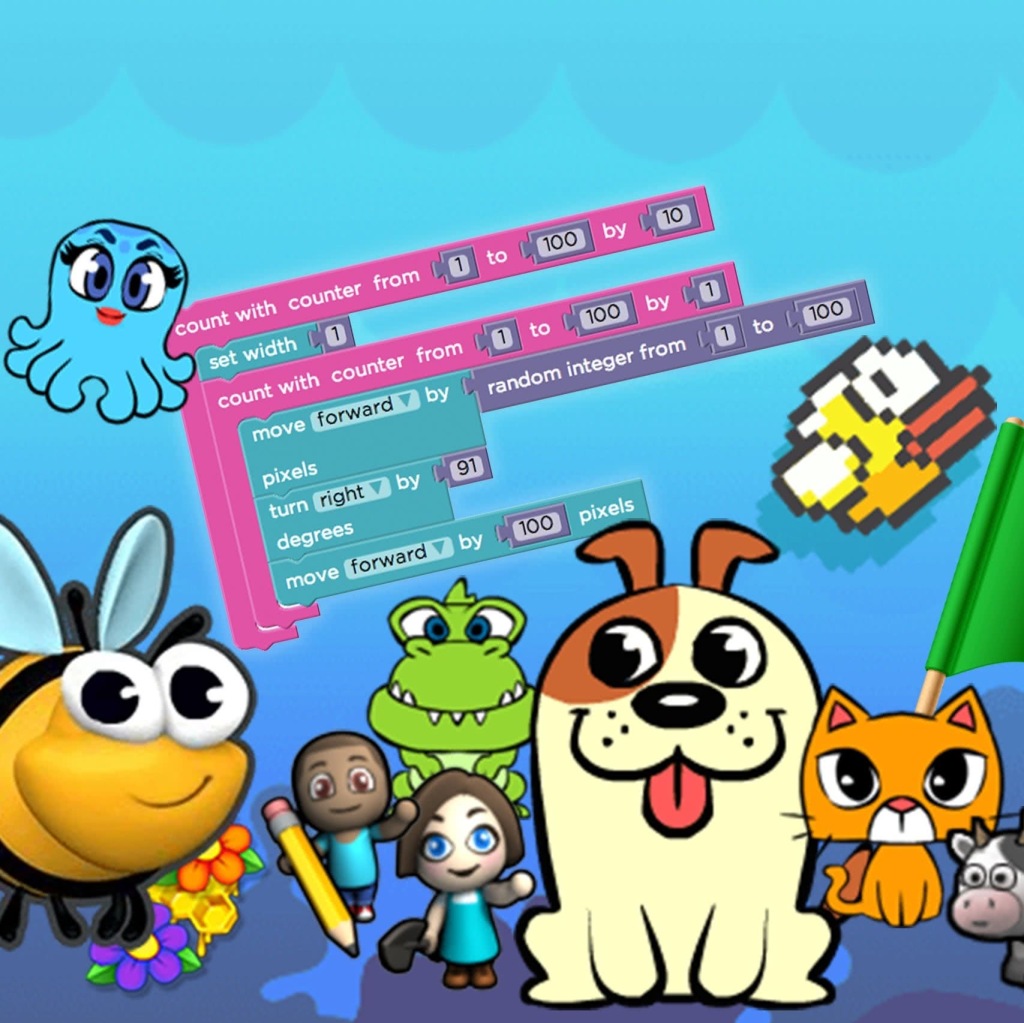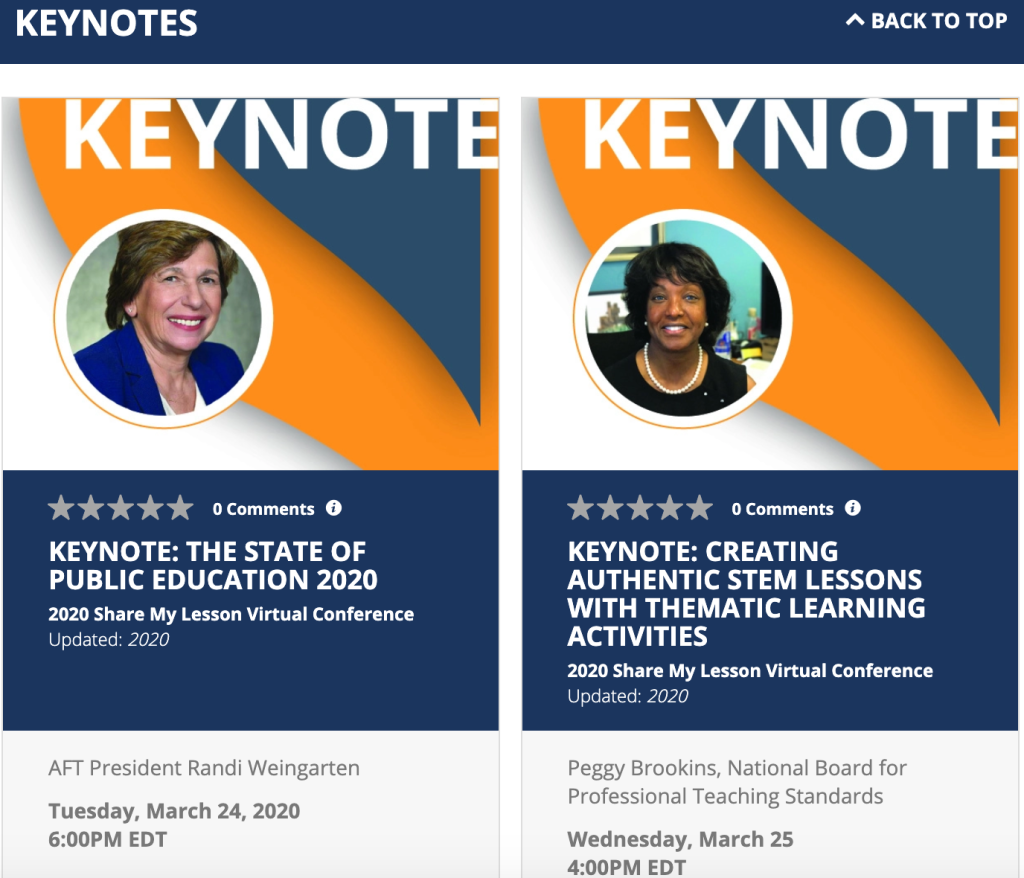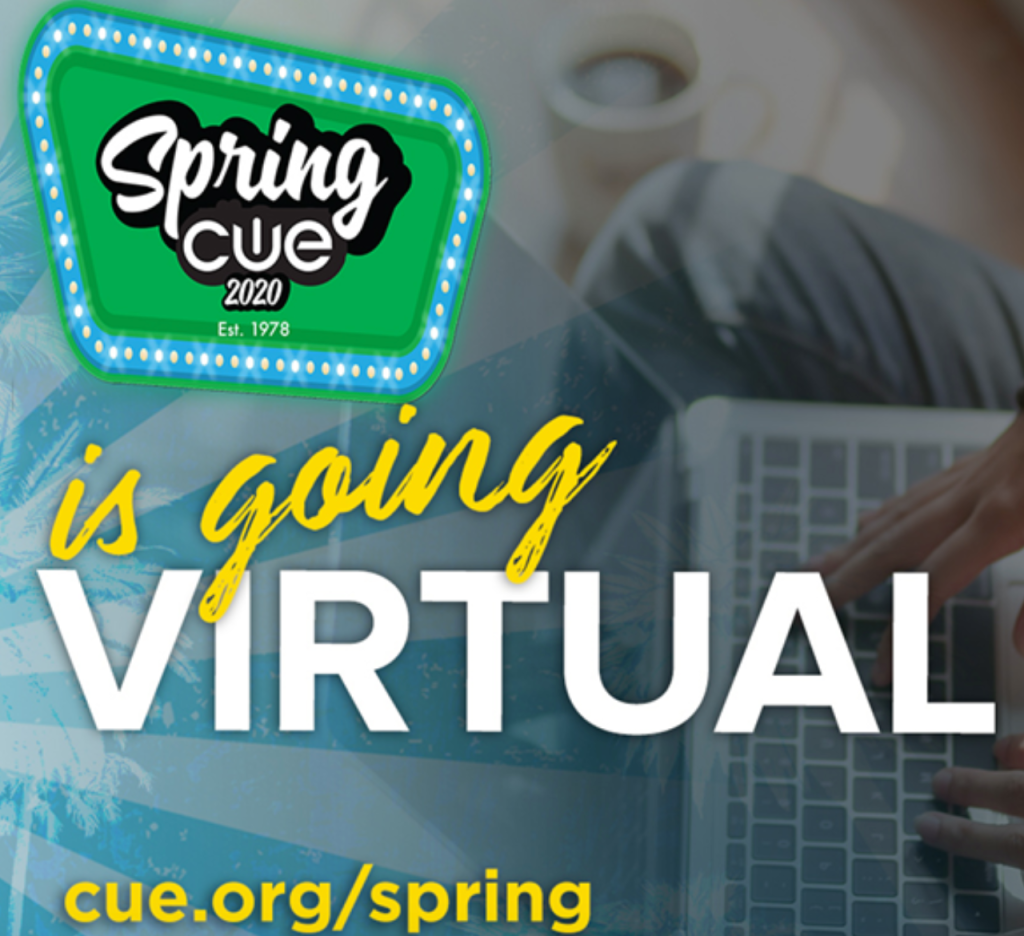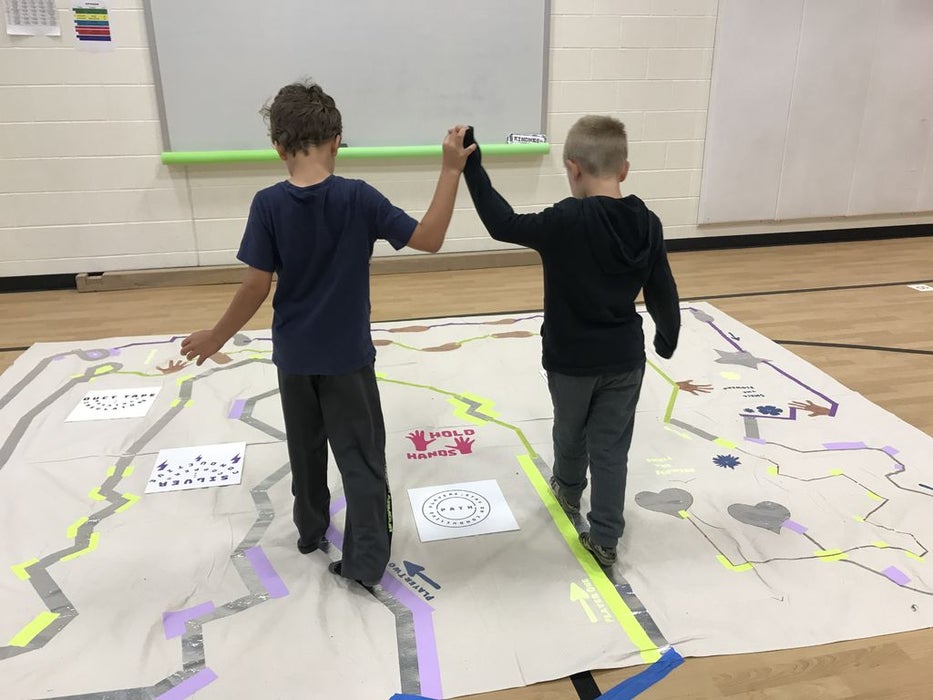Posts Tagged ‘STEAM’
Winter Holiday Display: A Great STREAM Project
I love celebrating the holidays and calendar events with my gifted students from my bilingual, Title 1 school. I ask them to make artifacts and displays that showcase both their talents and the holiday (see my blog posts about Dia de las Muertos and Pi Day for examples.) Not only are the projects fun, engaging, and exciting, they also provide opportunities for students to gain STEM/STEAM/STREAM knowledge and skills that address interdisciplinary standards. For this year, 2022, they created displays that included components for Christmas, Hanukah, and Kwanzaa. To do so, they . . .
- researched different components of the holidays, and created posters to go with the displays
- used art and engineering to make kinaras, gingerbread houses, and dreidels
- wired and used LEDs to light up their kinaras and gingerbread houses
- programmed micro:bits and Circuit Playgrounds to go with their displays
Introduction
I live in New Mexico. Knowledge of Hanukah and Kwanzaa is limited by our state population. so I began this project with holiday themed Kahoot quizzes (the kids love Kahoots). I think Kahoot quizzes are a great way to introduce new information to students. Here is a list of the ones I did with students:
- https://create.kahoot.it/share/winter-holidays/0a011bba-b79e-4044-9374-af7092aacc80
- https://create.kahoot.it/share/winter-holidays/332f63a4-e53d-45a1-8c87-c2328244c78d
- https://create.kahoot.it/share/winter-holidays-around-the-world/939312a6-cbca-4e4e-abdd-777433dc9846
During the quizzes, I visited websites to show students more information about the content being covered.
- Acquire and use accurately grade-appropriate general academic and domain specific words and phrases, including those that signal precise actions, emotions, or states of being and that are basic to a particular topic.
Researching the Different Winter Holidays
This is is the R in STREAM which translates into reading and writing. “STREAM adds one more layer to STEM and STEAM: reading and wRiting. Advocates of STREAM see literacy as an essential part of a well-rounded curriculum, as it requires critical thinking as well as creativity. STREAM projects are similar to STEM or STEAM, but fold in the components of reading and writing” (STEM vs. STEAM vs. STREAM: What’s the Difference?).
After selecting from a list of holiday-related topics, students researched, selected key points, and found applicable images to create posters for the displays. Here are the posters they created (noting that we are a bilingual Spanish class so some of them are in Spanish):
- Conduct short as well as more sustained research projects based on focused questions, demonstrating understanding of the subject under investigation.
- Draw evidence from literary or informational texts to support analysis, reflection, and research.
- Acquire and use accurately grade-appropriate general academic and domain specific words and phrases, including those that signal precise actions, emotions, or states of being and that are basic to a particular topic.
Hanukah Dreidels
Kathy Ceceri developed the Circuit Playground Dreidel – https://learn.adafruit.com/CPX-Mystery-Dreidel/overview. Kathy has them cut out their cardstock dreidels from a PDF. I created a template in Cricut so they could be cut out ahead of time. Here is a link to it https://design.cricut.com/landing/project-detail/6380fecebf31eaf51e587127. Due to the complexity of the code, students were provided with the one developed by Kathy.
Another kind of dreidel was made using CDs – see https://minds-in-bloom.com/make-dreidel-out-of-cd/.
Finally, students get to play the dreidel game (happening this coming week).
Standards Addressed
Next Generation Science Standards – Engineering
- Define a simple design problem reflecting a need or a want that includes specified criteria for success and constraints on materials, time, or cost.
- Social studies programs should include experiences that provide for the study of culture and cultural diversity.
- Anchor Standard #1. Generate and conceptualize artistic ideas and work.
- Anchor Standard #2. Organize and develop artistic ideas and work.
- Anchor Standard #3. Refine and complete artistic work.
Making Kinaras
“The kinara is a seven-branched candleholder used in Kwanzaa celebrations in the United States. During the week-long celebration of Kwanzaa, seven candles are placed in the kinara—three red on the left, three green on the right, and a single black candle in the center. The word kinara is a Swahili word that means candle holder. The seven candles represent the Seven Principles (or Nguzo Saba) of Kwanzaa. Red, green, and black are the symbolic colors of the holiday” (https://en.wikipedia.org/wiki/Kinara).
Students created the kinara by making tissue paper candle holders to make the kinara candles. See the Lighting section below on how they were lighted.
Standards Addressed
- Social studies programs should include experiences that provide for the study of culture and cultural diversity.
Making Gingerbread Houses
Making gingerbread houses is typically associated with Christmas time and it is a great activity for students. I purchased kits at deeply discounted websites like Five Below prior to the Christmas session. This means that the kits are quite old but they aren’t for eating, they are for display. To add another element of fun, I cut out the doors and filled them with Isomalt. This permitted students to add lights inside to micmic how a house might look like during Christmas (see next section on lighting).

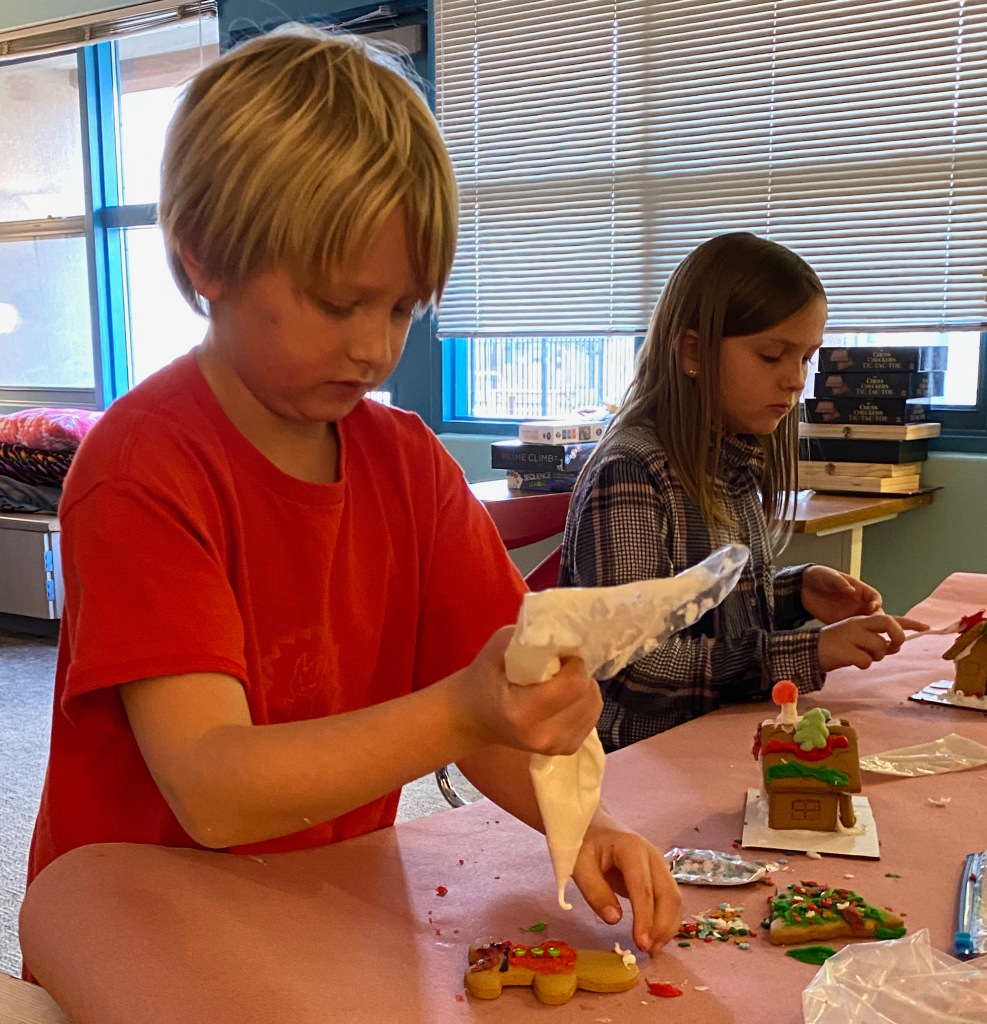
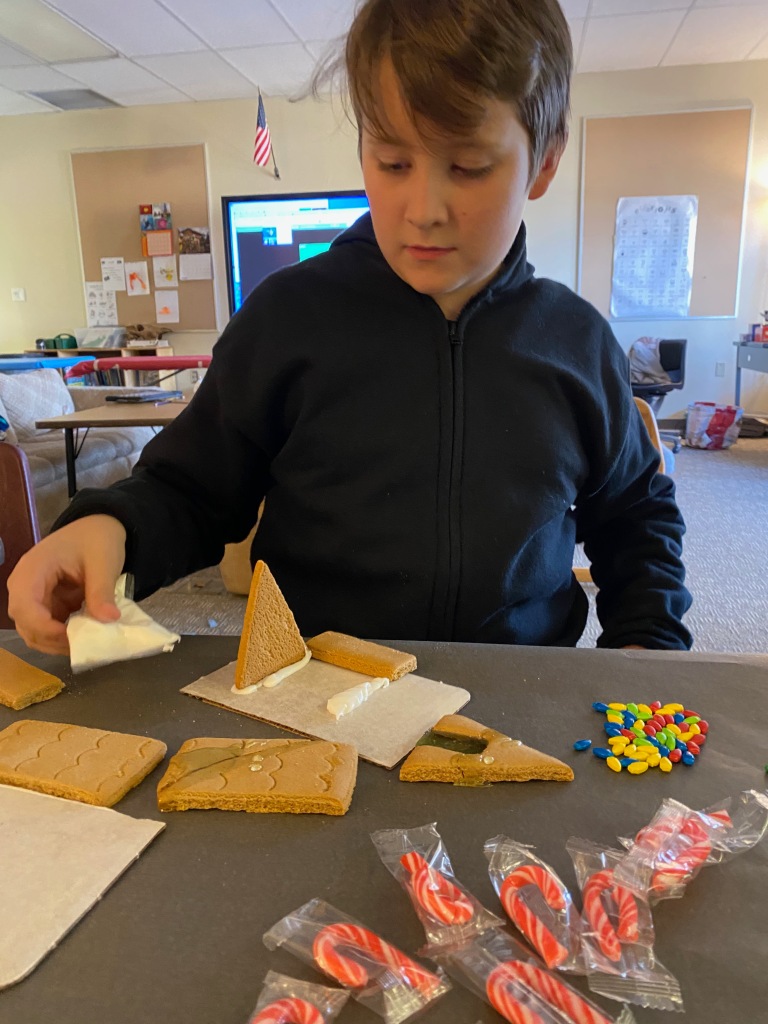



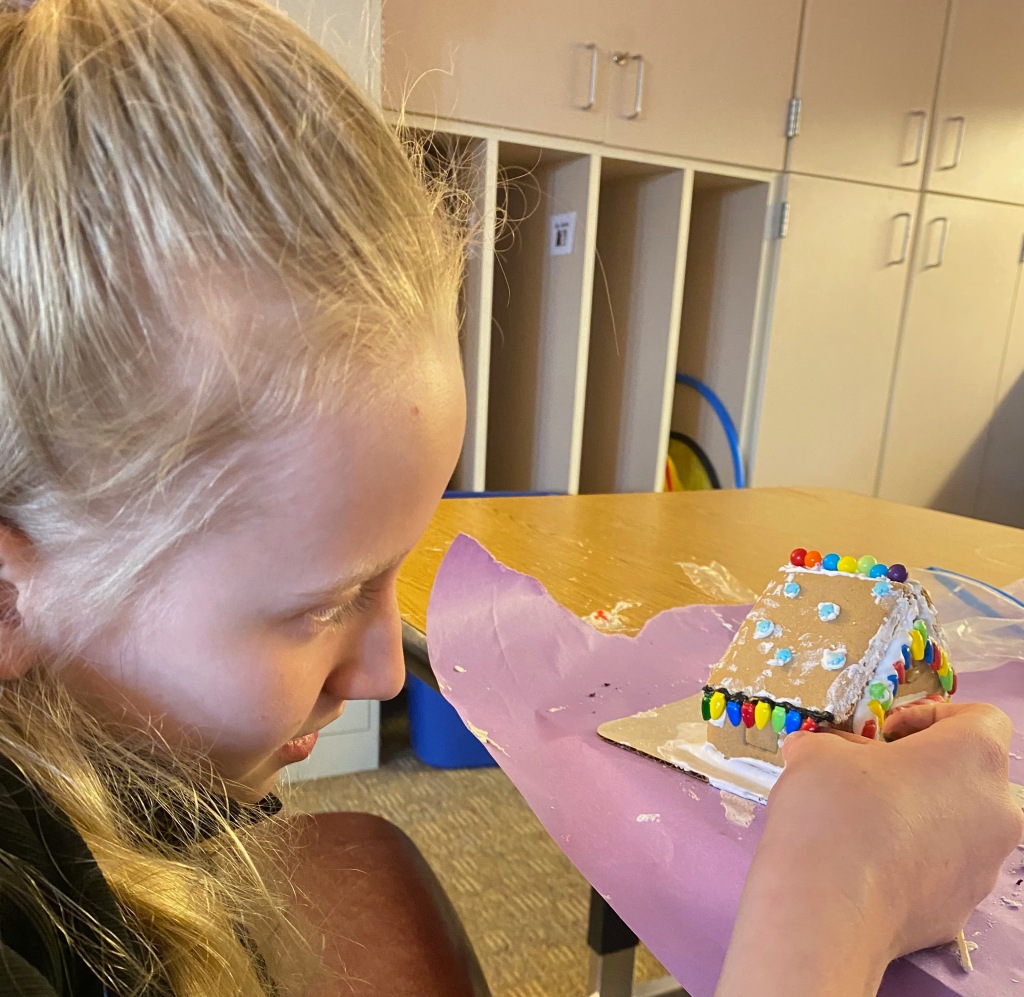
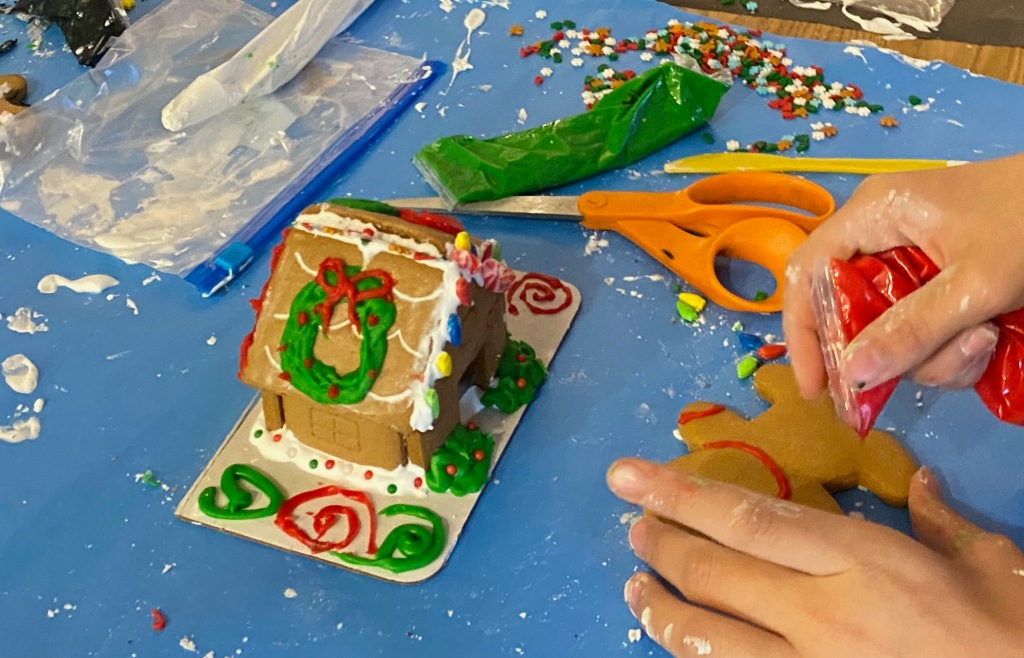

Standards Addressed
Next Generation Science Standards – Engineering
- Define a simple design problem reflecting a need or a want that includes specified criteria for success and constraints on materials, time, or cost.
- Anchor Standard #1. Generate and conceptualize artistic ideas and work.
- Anchor Standard #2. Organize and develop artistic ideas and work.
- Anchor Standard #3. Refine and complete artistic work.
Lighting Up the Kwanzaa Kinaras and Gingerbread Houses
Students learned some basics of electrical circuits using blinking LEDs. For their Kwanzaa Kinaras, they made simple LED/3V Lithium battery connections – see https://youtu.be/pIDB56RYT5M on how to do this.
To light up the inside of the gingerbread houses, the students combined 3 pre-wired LEDs (resistor built in) and a 9v battery in a series circuit (there wasn’t enough power for more than 3 in the circuit). One of the pre-wired blinking lights was placed in each of the gingerbread houses. The basics of how to do this can be found via this tutorial – https://youtu.be/DcN0Xlw7nko.
During the process of making and testing their circuits, we discussed how circuits worked, polarity, and conductive/insulting materials. The following video can help explain electrical circuits to younger students – https://youtu.be/HOFp8bHTN30
Standards Addressed
Next Generation Science Standards – Energy
- Make observations to provide evidence that energy can be transferred from place to place by sound, light, heat, and electric currents.
Lighting and Signage Using micro:bits
micro:bits were used to create signs wishing happy holidays. They were also used to light up Neopixel rings and strips.Here are some resources for the micro:bit component of the display:
- micro:bit Holiday Activities – https://microbit.org/news/2020-12-03/microbit-holiday-activities/
- Using Neopixels with the micro:bit – https://support.microbit.org/support/solutions/articles/19000130206-using-neopixels-with-the-micro-bit
- Sample Neopixel Makecode – https://makecode.microbit.org/72931-87952-73243-42587 and https://makecode.microbit.org/_VbyT1DT7uDKp
Standards Addressed
- Create programs that include sequences, events, loops, and conditionals.
- Modify, remix, or incorporate portions of an existing program into one’s own work, to develop something new or add more advanced features.
Next Generation Science Standards – Energy
- Make observations to provide evidence that energy can be transferred from place to place by sound, light, heat, and electric currents.
Math Connection
Although, I didn’t do so this year, I have included a math component to gingerbread house making in the past whereby students needed to learn about and calculate the perimeter and area of their creations (see Gingerbread House Making: A Fun and Engaging Cross-Curricular Lesson).
Dia de Muertos & Halloween Displays: A Meow Wolf-ish STREAM Lesson
I have the privilege of teaching gifted education in Santa Fe, New Mexico. Two unique characteristics of living and working here is (1) there is a strong Mexican population who have retained their beautiful culture – language, culture, food, and holiday, and (2) it is the birthplace of Meow Wolf, unique and immersive art installations with multimedia elements and a mysterious narrative throughout; whose mission is to inspire creativity in people’s lives through art, exploration, and play so that imagination will transform our worlds.
Because of these unique elements in my community, each year I ask the students to create Dia de los Muertos and/or Halloween story-driven and technology-enhanced displays which are put in the front foyers of my schools for the students and visitors to enjoy. They are project-based, high engagement (as students can draw on their individual strengths within their teams), and focus on student voice and choice. In other words, these projects become strong STREAM (Science, Technology, wRiting, Engineering, Art, Math)-based lessons which translates into being interdisciplinary. I believe all lessons should be interdisciplinary as I discuss in https://usergeneratededucation.wordpress.com/2019/01/13/all-lessons-should-be-interdisciplinary:
Standards Addressed
Due to the project’s cross disciplinary nature, standards were addressed from several disciplines:
Common Core State Standards – ELA
- CCSS.ELA-LITERACY.W.5.3 – Write narratives to develop real or imagined experiences or events using effective technique, descriptive details, and clear event sequences.
- CCSS.ELA-LITERACY.W.5.6 – With some guidance and support from adults, use technology, including the Internet, to produce and publish writing as well as to interact and collaborate with others.
- CCSS.ELA-LITERACY.W.5.10 – Write routinely over extended time frames (time for research, reflection, and revision) and shorter time frames (a single sitting or a day or two) for a range of discipline-specific tasks, purposes, and audiences.
Science Standard
- NGSS: 4-PS3-2. Make observations to provide evidence that energy can be transferred from place to place by sound, light, heat, and electric currents.
GSS Engineering Standards
- 3-5-ETS1-1. Define a simple design problem reflecting a need or a want that includes specified criteria for success and
- constraints on materials, time, or cost.
- 3-5-ETS1-2. Generate and compare multiple possible solutions to a problem based on how well each is likely to meet the criteria and constraints of the problem.
ISTE Standards for Students
- Know and use a deliberate design process for generating ideas, testing theories, creating innovative artifacts or solving authentic problems.
- Develop, test and refine prototypes as part of a cyclical design process.
- Exhibit a tolerance for ambiguity, perseverance and the capacity to work with open-ended problems.
- Create original works or responsibly repurpose or remix digital resources into new creations.
National Core Arts Standards
- Anchor Standard #1. Generate and conceptualize artistic ideas and work.
- Anchor Standard #2. Organize and develop artistic ideas and work.
- Anchor Standard #3. Refine and complete artistic work.
National Standards in Gifted and Talented Education
- 1.1. Self-Understanding. Students with gifts and talents recognize their interests, strengths, and needs in cognitive, creative, social, emotional, and psychological areas.
- 1.5. Cognitive, Psychosocial, and Affective Growth. Students with gifts and talents demonstrate cognitive growth and psychosocial skills that support their talent development as a result of meaningful and challenging learning activities that address their unique characteristics and needs.
The Lesson
One of the schools where I teach (I teach at two schools) has a large Mexican (self-identifying term) population and as such, each grade has a bilingual class. My students from this school were asked to create stories and displays based on Dia de los Muertos.
The events were as follows:
- Write a Thematic Story
- Review Possible Projects for Story
- Create Artifacts and Display
Write a Story About Dia de los Muertos or Halloween
With the older students, grades 4 through 6, I reviewed the story arc and explained that they needed to include all of those elements within their stories. With the younger kids, grades 2 and 3, I talked about characters, setting, and plot and reinforced including these elements in their stories. There were 2 to 4 students per group, so they collaborated on their stories using Google Docs. What follows is one of the stories written in English and then translated into Spanish:
English Version
Spanish Version
Links to Other Stories
- The Chupacabre – 5th and 6th Graders: https://docs.google.com/document/d/1rZEbwaanXQM8V83DbmQ9FmxAze0moZjSkICJLF5SaQw/edit?usp=sharing
- Story by 4th Graders: https://docs.google.com/document/d/1XWX3tPK_eiLavBDyIY5HRhwa5YHvWvsVGVrm4Kr5at8/edit?usp=sharing
- The Haunted House – 2nd and 3rd Graders: https://docs.google.com/document/d/1YFCodaGgBIDqp-DUx1Q1_DH9mrMWO3DPOHlr62jyr_E/edit?usp=sharing
- Story by 2nd Graders: https://docs.google.com/document/d/1C5uLkTLJmBhE78xkyg01TnTgIdJQyueFacgvuIQnEss/edit?usp=sharing
Story as a Storyboard That Comic
One student requested and created his group’s story as a comic as his other two groups members wrote their story out on Google Docs. Here are a few of his cells.



The rest can be view at https://www.storyboardthat.com/portal/storyboards/cdamm/classroom-public/unknown-story3
Review Possible Projects for Story Display
For possible artifacts to create their story-driven displays and as a way to honor voice and choice, students could select from the following projects:
If interested in a specific project, I would either provide the interested student and/or group with a link to a tutorial or give a mini-lesson on it.
Create Artifacts and Display
Individual groups selected a combination of the following artifacts:
- micro:bit Characters
- Neopixels – micro:bit driven
- Servos – micro:bit driven
- Sugar Skulls
- Paper Circuits Skulls and Pumpkins
- Laser Cut Objects Out of Wood
- Cardboard Construction Kits
- Jack-O-Lanterns Lit by Circuit Playgrounds
- Hummingbird Bits for Servos and Lights
Here is a slideshow of the students’ creation efforts:
Personal Reflection
The joy both my students experience throughout the lesson is palatable. I love listening to their excitement as they develop their stories. I love watching their smiles as they create their elements for their stories. I love seeing their bodies shake with excitement when their displays are complete, and I love witnessing their pride when the other students excitedly approach and comment on their displays.
Because I have students in my gifted program throughout their elementary years, I love seeing their excitement when we begin this project each year. I always try to introduce some new possibilities for their display elements each year. For example, this year I introduced and taught Hummingbird Bits which I learned about during a PD workshop this past summer. In addition, since I blog about this project each year as a means to document both students’ and my learning, I can see my own progress. Here is the blog post from the first two years I did it – Halloween Wars: An Interdisciplinary Lesson with a STEM, STEAM, Maker Education Focus. During the first year, I provided students with cookies, ping pong balls, LED lights, gummy worms, candy skeletons – no physical computing. So, for me, it is great to see my own growth, too.
Toy Take Apart and Repurposing: A Creative Problem-Solving Lesson
Toy Take Apart and Repurposing is always a great favorite both with my gifted students and with my campers during my summer Toy Hacking and Making camp. I purchase battery-operated toys from ebay and thrift stores. Because I am always seeking ways to improve my lessons, I was excited to add the repair mindset reflection, the micro:bit driven Plushpal, and circuit jewelry to this activity this past spring. These additions seemed to really enhance the lesson.
This lesson was driven by the following references and resources:
- Instructables’ Take Apart and Rebuild Toys – https://www.instructables.com/Take-Apart-and-Rebuild-Toys/
- Agency by Design’s Cultivating A Repair Mindset https://makezine.com/2022/04/20/cultivating-a-repair-mindset/
- micro:bit PlushPal – https://www.plushpal.app/ and https://www.notion.so/scientiffic/PlushPal-Guide-06def1796fd4420389ea33a5eb9ac897
- Instructables’ Circuit Jewelry – https://www.instructables.com/Circuit-Board-Earrings/
Toy Take Apart
Learners began by taking their battery operated toys apart. They were instructed to take it apart so all of the components were separated and to sketch the parts as they did so.
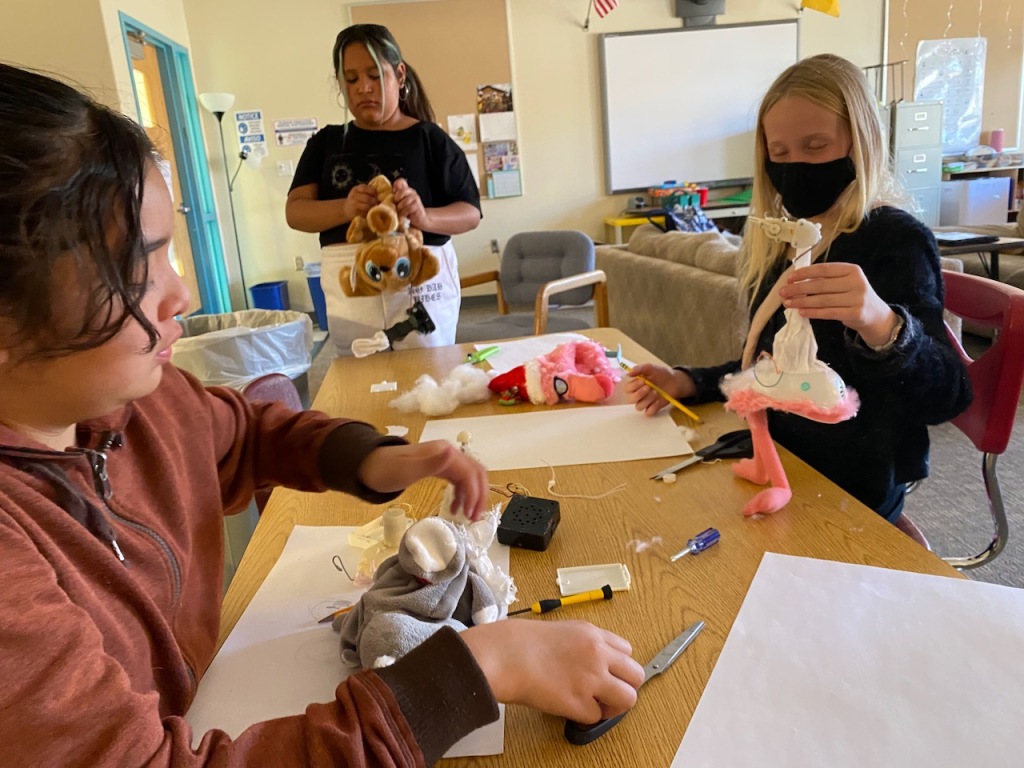

Repair Mindset Reflection
The Repair Exploration tool is designed to cultivate a sensitivity to and curiosity about how objects and systems work by looking closely at them (https://resources.makered.org/resource/cultivating-repair-mindset-toolkit).
After learners completed taking their toys apart, they were asked to used this tool to reflect on their learning. They put their answers directly on the paper where they made their sketches.
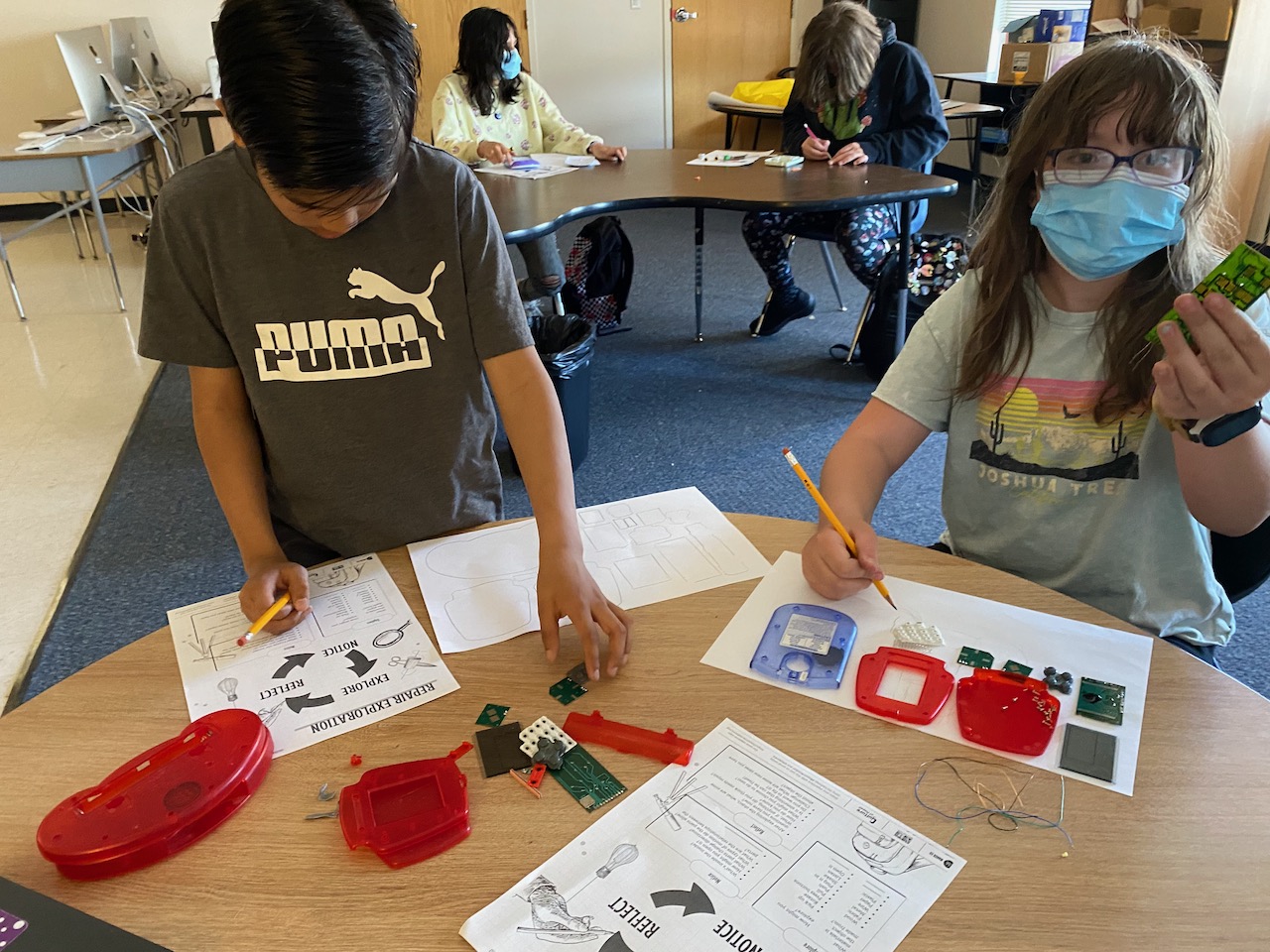
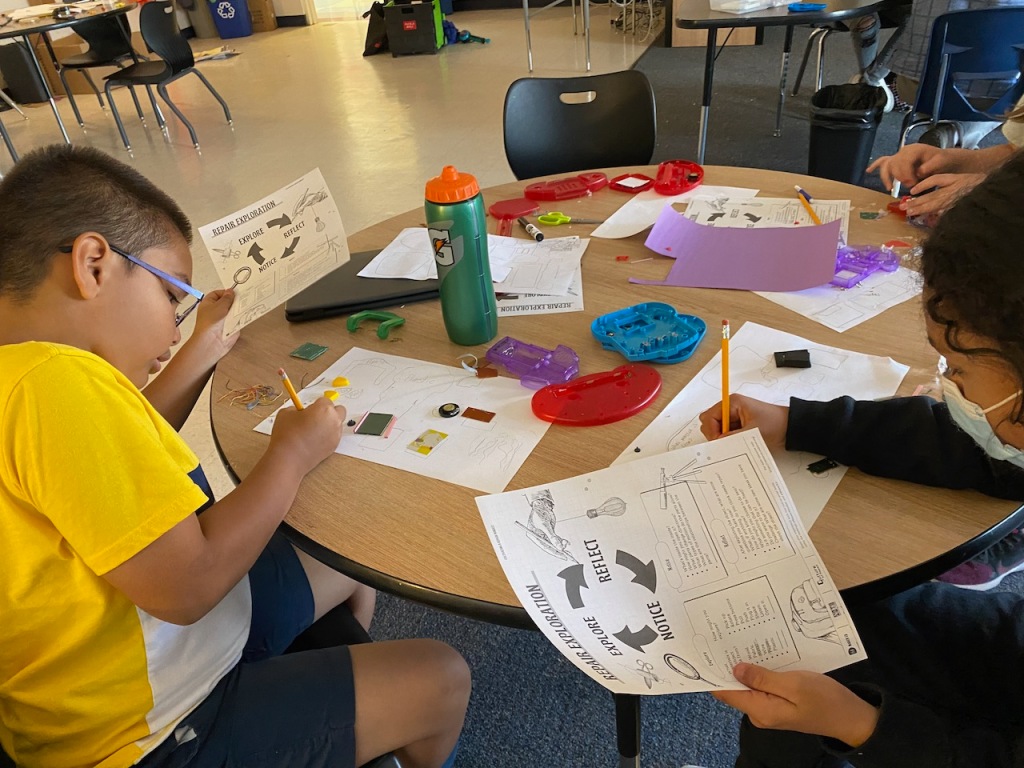
micro:bit PlushPal
PlushPal is a tool for creating interactive toys using the micro:bit. Using PlushPal, you can program your stuffed animal to respond with sounds based on custom gestures you create.
Link to the PlushPal Guide – https://www.notion.so/scientiffic/PlushPal-Guide-06def1796fd4420389ea33a5eb9ac897. The following video shows some learners trying out PlushPal:
Circuit Jewelry
In order to reinforce the concept of repurposing, learners got to use a circuit board from their toy (comes in all battery-operated toys) to make some jewelry.
Invention Literacy: Repurposing Toys Parts
Invention Literacy, as coined by Jay Silver of Makey Makey, “is the ability to read and write human made stuff.” To be invention literate, it means you’re able to look at the world around you and think about how something works. When students put on the hat of an inventor, they can see how the world works, and have the confidence to invent new parts of the world (https://sphero.com/blogs/news/invention-literacy).
The following video shows Theo repurposing-inventing his toy parts into something functional:
The following images show students repurposing-inventing their toy parts into a prototype for a new game:
Social Entrepreneurship with Elementary Students: A Perfect STEAM Lesson
I have done a social entrepreneurship unit with three groups of gifted students, grades 3rd through 6th. It was one of my favorite units . . . ever, and from their reactions, I believe it was one of theirs, too. I call it a perfect STEAM (science, technology, engineering, arts, and math) unit. The first part of this post explains some of the rationale for this project, and the second part describes the unit, itself.
Why a Unit on Social Entrepreneurship
First, I wanted my learners, who are from lower income families, to develop both an entrepreneur mindset and entrepreneur skills along with the creativity and innovation that comes with these skills.
Entrepreneurship education benefits students from all socioeconomic backgrounds because it teaches kids to think outside the box and nurtures unconventional talents and skills. Furthermore, it creates opportunity, ensures social justice, instills confidence and stimulates the economy. Because entrepreneurship can, and should, promote economic opportunity, it can serve as an agent of social justice. Furthermore, entrepreneurship has historically spurred minorities, women and immigrants to create better lives for themselves and their families. (Why Schools Should Teach Entrepreneurship)
Second, not only did I want my learners to gain entrepreneur skills, I wanted them to experience the benefits of starting a company in order to raise money to give to a “cause” also known as a form of social entrepreneurship.
Not every child is temperamentally suited to be a social entrepreneur. Not every child is suited to be a scientist, mathematician, or artist. But elementary school-age kids do have the natural curiosity, imagination, drive, and ability to come up with innovative ways to change the world for the better. By exposing our kids to a variety of disciplines, including social entrepreneurship, we are teaching them they have what it takes to “be the change.” One well-known expert on social entrepreneurship, David Bornstein, puts it this way: Once an individual has experienced the power of social entrepreneurship, he or she will “never go back to being a passive actor in society.” (Young Kids Need to Learn About Social Entrepreneurship)
Third, this unit met my own criteria for an effective and powerful unit:
- Instructional challenges are hands-on, experiential, and naturally engaging for learners.
- Learning tasks are authentic, relevant, and promote life skills outside of the formal classroom.
- The challenges are designed to be novel, and create excitement and joy for learners.
- Learner choice and voice are valued.
- Lessons address cross curricular standards. They are interdisciplinary (like life) where multiple, cross-curricular content areas are integrated into the instructional activities.
- Learning activities get learners interested in and excited about a broad array of topics especially in the areas of science, engineering, math, language arts, and the arts.
- Communication, collaboration, and problem solving are built into the learning process.
- Reading and writing are integrated into the learning activities in the form of fun, interesting books and stories, and writing stories, narratives, journalistic reports.
- Educational technology is incorporated with a focus on assisting with the learning activities not to learn technology just for the sake of learning it.
- There is a natural building of social emotional skills – tolerance for frustration, expression of needs, working as a team.
Schedule of Learning Activities
Here was the schedule of learning activities I used for this unit:
- Introduction
- Video
- Online Games
- Kidpreneurs
- Market Survey – Google Form
- Analyzing Results, Deciding of Products, Testing Products
- Expense Sheet – Expenses and Assets
- Business Plan
- Making and Selling the Products
- Visiting the Interfaith Homeless Shelter to Deliver the Profits
Introduction
The following activities were used to teach learners about entrepreneurship and social entrepreneurship:
Video. Learners were first introduced to entrepreneurship with the following video:
Kidpreneur Readings. We read the Kidpreneurs’ book and did exercises from book – these readings and exercises continued throughout the unit.
Online Games. They were then given the opportunity to play some online games that focus on entrepreneurship:
- Lemonade Stand – http://www.coolmath-games.com/0-lemonade-stand
- Coffee Shop – http://www.coolmath-games.com/0-coffee-shop
- Building Rush – https://www.coolmath-games.com/0-building-rush
- Cookie Tycoon – http://www.addictinggames.com/strategy-games/cookietycoon.jsp
- The Uber Game – https://ig.ft.com/uber-game/
Market Survey
Based on their own interests and hobbies (and with the help of the Kidpreneur workbook), my learners decided on possible products they could make (all products were handmade) and sell. They developed a market survey from this information:
Analyzing Results, Deciding of Products, Testing Products
Learners requested that their respective classes and family members take their survey. It was quite a treat watching them continually examine the graphs found on the Google form response page. Here is an example from one group’s survey:

From the results, they decided to sell:
- Orbeez Stress Balls – see https://youtu.be/DK1q7WjxcQc for instructions,
- Fingerboards – se https://youtu.be/PS0nmiMkPiY for ideas how to create these,
- Pop Its – see http://www.ikatbag.com/2021/02/cardboard-popper-tutorial-by-kate.html for instructions,
- Sugar Christmas Cookies – see https://www.allrecipes.com/recipe/10402/the-best-rolled-sugar-cookies/ for the recipe the kids used.
They started by testing out how to make these products to discover how to best produce them.
Expense Form
I acted as the bank and purchased the materials for the learners to make products. I saved the receipts, made copies of them, and had each learner create her or his Google sheet to record expenses.
Business Plan
From all of this information, the learners developed a business plan using the following Kids-Business-Plan simplified for kids. It included:
- Their business name – Gifted Community Craft Story
- Startup costs
- Cost per item
- Marketing strategies
Highlights – Making and Packaging the Products
Here is a photo essay that shows the students making and packaging the products.
Highlights – Selling the Products
Students Delivering Raised Monies to The Interfaith Community Shelter (serves the homeless)
Standards Addressed
Framework for 21st Century Learning
Financial, Economic, Business, and Entrepreneurial Literacy
- Know how to make appropriate personal economic choices
- Understand the role of the economy in society
- Use entrepreneurial skills to enhance workplace productivity and career options
Common Core State Standards – Math (budgets and money management)
- Use place value understanding and properties of operations to perform multi-digit arithmetic.
- Use the four operations to solve word problems involving distances, intervals of time, liquid volumes, masses of objects, and money, including problems involving simple fractions or decimals, and problems that require expressing measurements given in a larger unit in terms of a smaller unit. Represent measurement quantities using diagrams such as number line diagrams that feature a measurement scale.
Common Core State Standards – ELA
- Present claims and findings, sequencing ideas logically and using pertinent descriptions, facts, and details to accentuate main ideas or themes; use appropriate eye contact, adequate volume, and clear pronunciation.
ISTE Standards for Students
- Students use a variety of technologies within a design process to identify and solve problems by creating new, useful or imaginative solutions.
- Students develop and employ strategies for understanding and solving problems in ways that leverage the power of technological methods to develop and test solutions.
NAGC Standards
- Students with gifts and talents demonstrate their potential or level of achievement in their domain(s) of talent and/or areas of interest.
- Students with gifts and talents develop knowledge and skills for living in and contributing to a diverse and global society.
- Students with gifts and talents demonstrate personal and social responsibility.
- Students with gifts and talents develop competence in interpersonal and technical communication skills. They demonstrate advanced oral and written skills and creative expression. They display fluency with technologies that support effective communication and are competent consumers of media and technology.
Additional Resources
- Ten Helpful Tips To Becoming An Kidpreneur [a kid that is an entrepreneur] https://www.huffingtonpost.com/entry/ten-helpful-tips-to-becoming-an-kidpreneur-a-kid-that_us_58d42f17e4b0f633072b35c6?ncid=engmodushpmg00000004
- Lesson Plans – Teaching Entrepreneurship http://www.teachingentrepreneurship.org/category/lesson-plans/
Science-Based Valentine Day Projects
I really like using maker education and STEM/STEAM projects to celebrate holidays and special events. My method of teaching new concepts is to use the Stages of Make Education that I presented in Learning in the Making: How to Plan, Execute, and Assess Powerful Makerspace Lessons:
The following Valentine Day projects were completed by my 3rd through 6th grade gifted students. Due to the new skills involved, they were asked to copy the basic instructions. Then as is typical of my students, then went quickly into the Advance and Embellish Stages of Making.
Circuit-Based Valentine’s Projects
NGSS Standards Addressed
- Make observations to provide evidence that energy can be transferred from place to place by sound, light, heat, and electric currents.
- Apply scientific ideas to design, test, and refine a device that converts energy from one form to another
Introduction
I began asking who knew what an electric circuit. Sadly, none did. I showed them Electric Circuits – BrainPop UK https://youtu.be/3LsXGAbwTOQ
Circuit Project 1: Conversation Hearts Box Operation Game
Project Description
The Instructable, Operation Valentine: a Game, a Gift, a Lesson in Electric Circuits, was used for this project. I substituted aluminum tape for the paperclip and pre-wired LEDs instead of the Christmas lights.
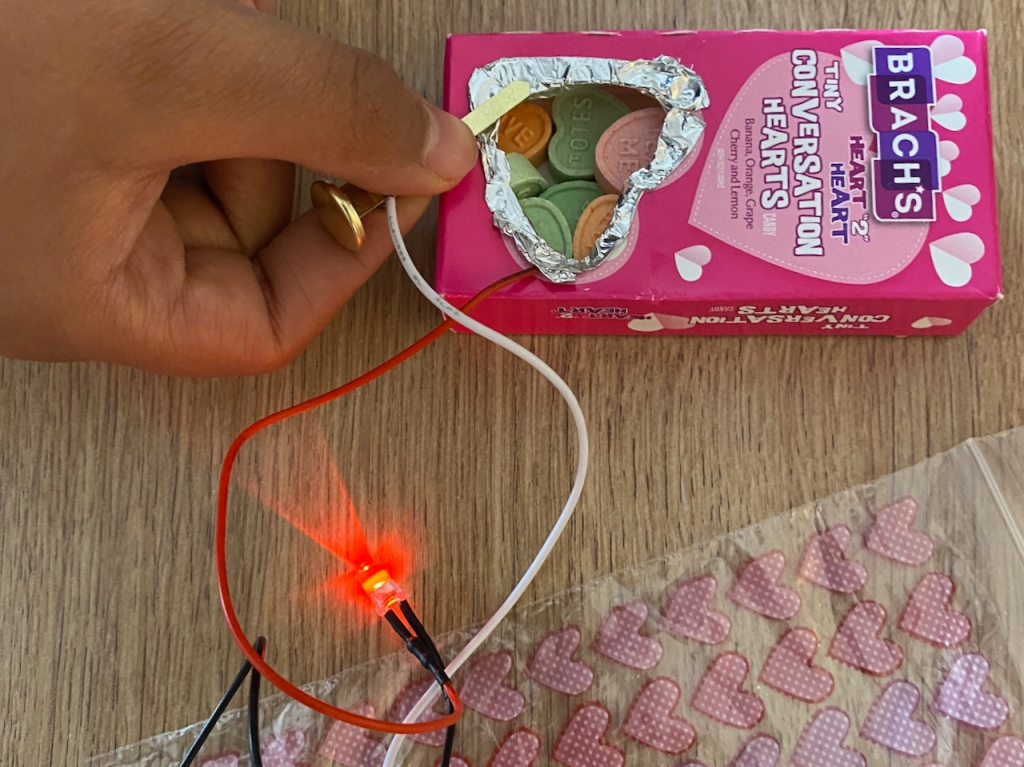


What follows is a video that shows how one student took this project from Copy to Embellish of the Stages of Making:
Circuit Project 2: Chibitronic LED Valentine Day Card
For this activity students were asked to create a Valentine Day card by making a paper circuit using a Chibtronic LED and a cardstock switch built into the circuit. I adapted the activity from two activities from their website:
- https://chibitronics.com/2020/02/15/valentine-light-up-card/
- https://chibitronics.com/2020/02/05/happy-valentine-with-light/
I cut out the front “cover” of the card using my Cricut machine to show a heart where the light would shine through. The students chose a piece of colored tissue paper to cover it. Instead of providing a circuit temple, I drew it on the whiteboard and asked the students to draw their own on another piece of cardstock.


This student were from the Copy Stage to the Advance Stage of Making by creating a popup card he figured out and crafted:
A Little Chemistry
NGSS
By the end of middle school, students will be able to apply understanding that pure substances have characteristic physical and chemical properties
Introduction
I showed them Physical and Chemical changes (Brain pop) https://youtu.be/hq8K-dF8_4c
Project Description
I used the following video as my reference for both materials and procedures:
What the students’ molds and candy looked like . . .
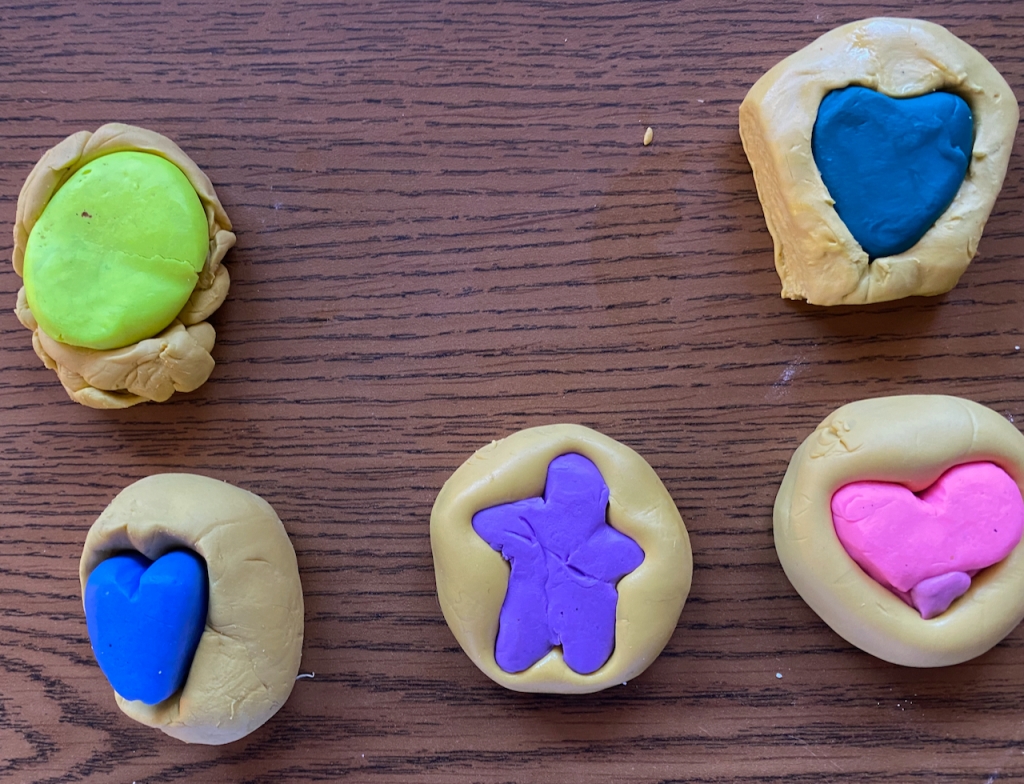

Paper Bobsled: STE(A)M Olympics-Related Lesson
I’ve discussed experiential learning in The Imperative of Experiential and Hands-On Learning and the lesson I describe in this post meets the characteristics I described in that blog post:
In an effort to engage students both in a STEM activity and learn more about the Olympics, I created a lesson on bobsledding.
Standards Addressed
As a STE(A)M lesson, it addresses cross-curricular standards:
Next Generation Science Standards (Science)
- Develop a model to describe that when the arrangement of objects interacting at a distance changes, different amounts of potential energy are stored in the system [Grades 6-8]
- Construct, use, and present arguments to support the claim that when the motion energy of an object changes, energy is transferred to or from the object. [Grades 6-8] (Source: http://teachers.egfi-k12.org/build-a-bobsled-racer/)
ISTE Standards (Technology)
(Technology is not heavily used in this lesson. Videos are used, though, to share content.)
- Students critically curate a variety of resources using digital tools to construct knowledge, produce creative artifacts and make meaningful learning experiences for themselves and others.
Next Generation Science Standards (Engineering)
- Define a design problem that can be solved through the development of an object, tool, process or system and includes multiple criteria and constraints, including scientific knowledge that may limit possible solutions.
- Analyze data from tests to determine similarities and differences among several design solutions to identify the best characteristics of each that can be combined into a new solution to better meet the criteria for success.
- Develop a model to generate data for iterative testing and modification of a proposed object, tool, or process such that an optimal design can be achieved.
National Core Art Standards
- Generate and conceptualize artistic ideas and work.
- Organize and develop artistic ideas and work.
- Refine and complete artistic work
Math Standard (see math labs below)
- Represent using pictures, diagrams, graphs, tables, numbers, words, and/or symbols (e.g., use tables to record data such as how fast the [bobsled] goes down the run, measure the length/width/height of the completed [bobsled] run). (Source: https://www.teachengineering.org/lessons/view/uno_gaitway_lesson01)
The Hook
Students are shown the following videos to get them familiar with bobsledding (none of my students knew what it was) and the physics of bobsledding:
Making the Paper Bobsled and Track
I created the following tutorial to teach students how to make a paper bobsled and the track:
To build your track, you can use the following templates for your tracks:
- Straight tracks https://docs.google.com/drawings/d/1nhPqWyPIAZ4aQ2INn-oPDgK1jNOwpTwY8y9Wk0sLPZg/edit?usp=sharing for
- Curves https://docs.google.com/drawings/d/1Wyl2kBrlWJkC_mMeg8phIQx9Bx8tyeBsODMSczLoojU/edit?usp=sharing
Math Connections
One or both of the following math labs can be added to the lesson:
- Calculating Average Speed of a Rolling Marble (in this case – a bobsled) –
- Roller Coaster Math
Process-Oriented Reflection Questions
Here are some questions for students to reflect upon during their making process:
- What factors influence how fast your bobsled travels down the track?
- Would your bobsled go faster if a lot or a little of the bobsled touched the track?
- Would more weight increase or decrease the speed of your bobsled?
- Would the position of the weight affect the speed of your bobsled?
- What is friction and what influence does it have on your bobsled?
- What is the Engineering Design process?
- Why is it important to make one modification to your bobsled at a time?
- What type of energy does the bobsled have when it is at the top of the track56half way down the track and at the bottom of the track?
- Do you think that your bobsled would travel more quickly or slowly on a straight or hilly track? (Source: Design Challenge: Echo Base Bobsleds)
Halloween Displays: A Perfect STREAM (Science, Technology, wRiting, Engineering, Art, Math) Lesson
Wow, wow, wow! My students finished their displays in time for Halloween after spending many, many hours working on them. Now, they are in display cases in the lobby of our elementary school. I am so proud of them and rightfully, they are very proud of themselves, too. They worked so hard on them.
A little history . . . I love Food Channel’s competitions and Halloween Wars tops my list. This is where I got the idea for this lesson. Each Halloween season, I become enamored with the passion, creativity, talent, and skill of the sugar, cake, and pumpkin artists on this show. This led me into wanting to bring this type of passion into my classrooms; so several years ago I started a yearly Halloween Wars during each Halloween season (none during our COVID shutdown, though); and yes, it’s a team competition which makes it even more exciting for the students. Needless to say, I was thrilled to bring it back this year allowing a new group of students the opportunity to experience it. As mentioned in the title, I believe this to be a perfect STREAM (Science, Technology, wRiting, Engineering, Art, Math) lesson. This post describes the learning activities and standards addressed.
Background Information
The principles that drive my instructional approach. regardless of theme, include:
- Instructional challenges are hands-on and naturally engaging for learners.
- There is a game-like atmosphere. There are elements of play, leveling up, and a sense of mastery or achievement during the instructional activities.
- The challenges are designed to be novel and create excitement and joy for learners.
- There is a healthy competition where the kids have to compete against one another.
- Learners don’t need to be graded about their performances as built-in consequences are natural.
- There is a natural building of social emotional skills – tolerance for frustration, expression of needs, working as a team.
- Lessons are interdisciplinary (like life) where multiple, cross-curricular content areas are integrated into the instructional activities.
These have been further discussed in A Model of Good Teaching?
The goals included the following:
- To work in a small group to create a Halloween scene using art work, LEDs, microcontrollers, servos, food items, and miscellaneous materials.
- To work as a small group to craft a story about their scene.
- To introduce and reinforce ideas, concepts, and skills associated with maker education, STEM, STEAM, and STREAM.
- To engage in a friendly team competition whereby collaboration in their small groups would lead to success in the competition.
Descriptions of the Individual Components
Science Related Activities and Standards
Learners did several activities that involved LED circuits (simple LED lights, LED Tea Light Spider Pumpkins, and Paper Circuit Skulls) and circuits with microcontrollers (see Technology section).
Science Standard:
- NGSS: 4-PS3-2. Make observations to provide evidence that energy can be transferred from place to place by sound, light, heat, and electric currents.
Technology Related Activities and Standards
For their displays, learners used servo socks to make parts of their display turn, micro:bits and servos to make milk carton robots, and Circuit Playground to make a flickering light to put inside their carved pumpkins. They needed to code their micro;bits and Circuit Playgrounds.
Computer Science Standards:
- 1B-CS-02 – Model how computer hardware and software work together as a system to accomplish tasks.
- 1B-AP-10 – Create programs that include sequences, events, loops, and conditionals
- 1B-CS-03 – Determine potential solutions to solve simple hardware and software problems using common troubleshooting strategies

wRiting – Language Arts Related Activities and Standards
Learners wrote stories that drove their displays. They did so in Google docs so they could write collaboratively. My “rule” was that they could only use elements in their displays that were part of their stories. This necessitated that they revisit their stories throughout this lesson.
ELA Standard:
- CCSS.ELA-LITERACY.W.5.3: Write narratives to develop real or imagined experiences or events using effective technique, descriptive details, and clear event sequences.
Example Stories:
Engineering Related Activities and Standards
Overall, engineering was used throughout this project from creating display artifacts – one student built a cardboard refrigerator with working parts and the milk carton robot to figuring out how to hang and arrange things on their display board.
NGSS Engineering Standards:
- 3-5-ETS1-1. Define a simple design problem reflecting a need or a want that includes specified criteria for success and
- constraints on materials, time, or cost.
- 3-5-ETS1-2. Generate and compare multiple possible solutions to a problem based on how well each is likely to meet the
- criteria and constraints of the problem.

Arts Related Activities and Standards
The entire display was an arts related activity, but I include a specific art activity, the Spooky Halloween 3D Art Project.
National Core Arts Standards:
- Anchor Standard #1. Generate and conceptualize artistic ideas and work.
- Anchor Standard #2. Organize and develop artistic ideas and work.
- Anchor Standard #3. Refine and complete artistic work.
Math Related Activities and Standards
Learners made their own Sugar Skulls and Gummy Legos (Bears) using recipes I projected on the Smartboard. They were asked to cut the recipes in half or thirds.
Math Standard:
- CCSS.MATH.CONTENT.5.NF.B.7: Apply and extend previous understandings of division to divide unit fractions by whole numbers and whole numbers by unit fractions.
It was so much fun to find and design these activities but it was even more fun watching the learners do them all. I can’t wait until next year!
The Role of Kits in Maker Education and STEM Learning
There has been a fair amount of criticism leveraged against “paint-by-numbers” types of STEM and maker kits. This criticism revolves around the stifling of the creativity of learners. I contend that learners need foundational skills so that they can be freed up to be creative. Think about learning how to cook or play an instrument. The basic and foundational skills need to be there in order for the makers to go in directions that are new and creative for them.
This past spring we returned to face-to-face teaching but students could stay remote if they and their parents chose that. Half of my student selected that option. I was able to purchase DEUXPER Science Experiments DIY Kits – one for each learner – through DonorsChoose. For the students at home, I delivered the kits to them.
The kids in both groups thoroughly enjoyed making the projects. There are several benefits for learners in making from a kit:
- I discussed stages of being a maker learner in my book Learning in the Making: How to Plan, Execute, and Assess Powerful Makerspace Lessons. As described for the Copy Stage, doing prescribed, step-by-step, procedural projects helps with scaffolding. They help build foundational skills for learners to be able to make more complex, open-ended, and self-driven projects.
- Following Directions or Step-by-Step Procedures – This is a life skill in that putting things together is a beneficial for later in life. Lots of things folks purchase come in parts that have to be put together.
- Learning How Things Work – By seeing the individual parts of a project prior to them being combined into a whole, working project, learners get to see how things work.
- Perseverance – For more complicated kits (which I use), the learners almost always have a challenge to face. I will not directly help them. I ask them to persevere. I also suggest they ask one of their peers for assistance. Learners really enjoy giving one another tips for constructing their projects.
- Feelings of Accomplishment – in completing a difficult task. The looks of joy and pride in completing their projects were a beautiful site to see. It was also fun seeing the joy they had in playing with the projects they created.
My Educational Learning Plan for the Coronavirus-Induced Hiatus
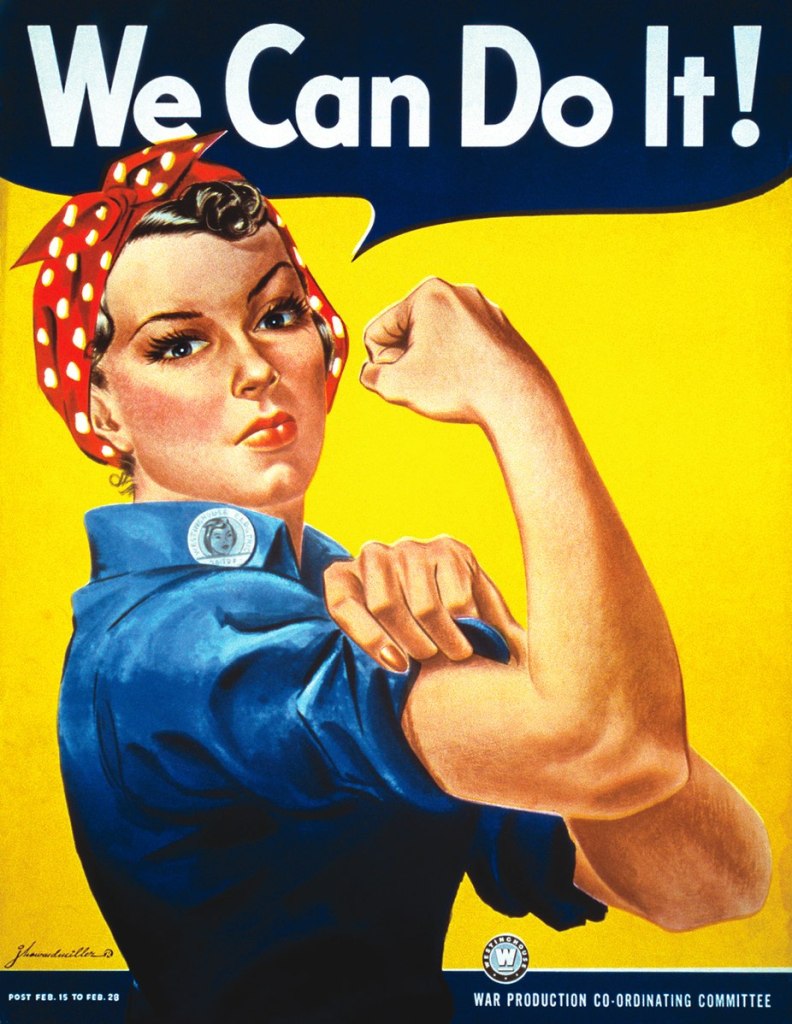
I, like many of you, have gone into a somewhat involuntary social distancing and isolation (mostly) due to my school and health club closures and recommendation to stay away from crowds. It’s just my cats and I (gives new meaning to home alone). Having a plan to engage my mind and body is of utmost importance. I am sharing my plan of activities, which are almost all free, as it may give other educators some ideas. If you have additional ideas, please share them in the comments.
Working Remotely with My Gifted Elementary Students
I work with gifted students one day a week. Our state and thus my district made an extremely quick decision to close the schools – heard last Thursday night and was told to send home with students Chromebooks along with lessons on Friday, a half day. Obviously most of the teachers didn’t have time to develop lesson plans and learning activities. I met with my learners quickly on Friday, as so much was going on, and asked them to check in with a shared Google doc and our Google Classroom. What follows are the general tasks they are being asked to do during our regularly scheduled gifted day.
- Writing Children’s Book Narrative – Prior to the school closing, my learners spent quite a bit of time learning how to write a children’s book using a Dr. Seuss type of writing style (yes, I know he is controversial but I like his writing style). The goal is to have them write their stories, illustrate them with cut out shapes made with a Cricut or a laser cutter, and then create Makey Makey Talking Books out of them. They just reached the point of writing their own narratives when the school closed. I asked each of them to share their stories with me via a Google doc. They were instructed to add to their stories during our hiatus, that I would provide feedback and suggestions directly on their shared Google docs. Then when we return, we can jump into creating the illustrations.
- Newsela – For those who don’t know, Newsela is best-in-class library of high-interest, cross-curricular current news and nonfiction texts.. They have offered all teachers access to Newsela ELA, Newsela Social Studies, Newsela Science and the SEL Collection for FREE for the rest of the school year. At home, my learners are being asked to do the same thing they do in class – pick an article of personal interest, read it, and take the quiz where they need to get at least 3 out of 4 correct. If they don’t, they need to choose another article to read and follow the same procedure.
- Prodigy Math Game – For those who don’t know, Prodigy is no-cost math game where kids can earn prizes, go on quests and play with friends — all while learning math. With Prodigy math homework is disguised as a video-game. My learners love it. I typically don’t give them class time to play it as I prefer hands-on, learner-to-learner interactive math activities. Since they will be at home, I asked them to play it for an hour during our typical gifted days to keep up with and improve their math skills.
- Code.org – My 4th graders have working through the Code.org Course F . They were asked to continue working on this through our hiatus while my 5th and 6th graders were asked to join and work on the Code.org CS in Algebra.
- Maker Camp – https://makercamp.com/project-paths/ and the Maker Stations Home Pack (see download below) : Since we do a lot of making in my gifted classes, I am requesting that my learners pick a project or two to try at home. It has been posted as an assignment via Google Classroom and they have been asked to post pictures of it. I will later (at school or at home depending how long the school closing lasts) ask them to blog about their processes.
Here is their schedule that I posted in Google Classroom for them.

The online applications – Newsela, Prodigy, and Code.org – have teacher dashboards so I can track progress and give them feedback. For their writing, I can give feedback directly on their Google docs, and for their maker projects, they are to post pictures to Google classroom.
Professional Development – Virtual Style
I plan on doing some PD in my pajamas – in other words, virtual style.
Attending Some Virtual Conferences
- 2020 Share My Lesson Virtual Conference – is a free virtual conference from March 24-26, with over over 30 webinars focusing on instructional strategies across the curriculum, social-emotional learning, activism, STEM, and trauma-informed practices. This is a fantastic conference. I attend every year. The sessions and presenters from professional organizations are top notch!
- CUE Spring Conference – Computer-Using Educators (CUE) is a California-based non-profit that offers a premiere educational technology conference each spring. This year, because of coronavirus, they are going virtual offering sessions from March 19 through April 5. There is a $75 fee for the virtual conference.
Taking Some Online Classes
- The Power of Mathematics Visualization – There is a nominal fee for this course but it looks good and might help me develop some interesting strategies for teaching mathematics to my gifted students.
- Code Academy Pro – They are offering Pro free to students and teachers. It’ll give me an opportunity to learn some advanced code.
Doing Some Maker Projects
Because I use lots of maker education projects in my gifted education classes and our school has a new STEAM lab, this forced hiatus is giving me the opportunity to try out some new projects including:
- Strawbees – micro:bit St Pinball Machine
- Collaborative Makey Makey Sensory Maze
- Stained Glass Linear Equations Project
- Rockets Class
- LilyPad ProtoSnap Plus
- Cricut Machine (bought it off of ebay a while back)
My Physical Health
I work out in group fitness classes several days a week. It verges on addiction. When I don’t get to do so, I get stressed out. Plus, it provides me with needed social interactions. So when my health club decided to limit their services, I became distraught. Luckily, though, I live in Santa Fe, New Mexico, so I plan to go on lots of hikes and am fixing up my bicycle to ride – hoping that the weather permits it. I am going to do online fitness classes. Oh, and, of course, cleaning my house from top to bottom will add an other fitness element. I absolutely know my physical workouts and health will positively affect my mental health.
